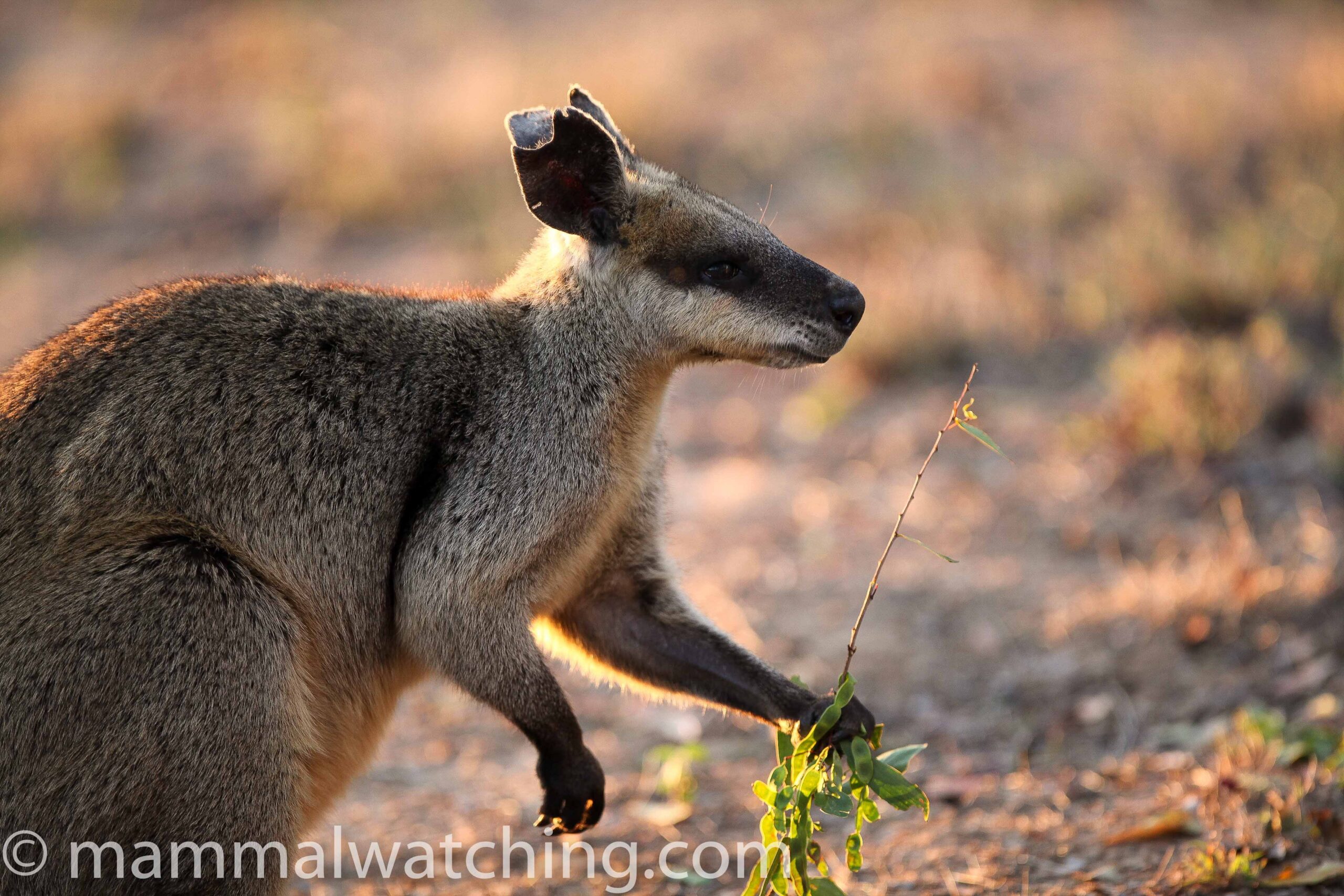
Queensland
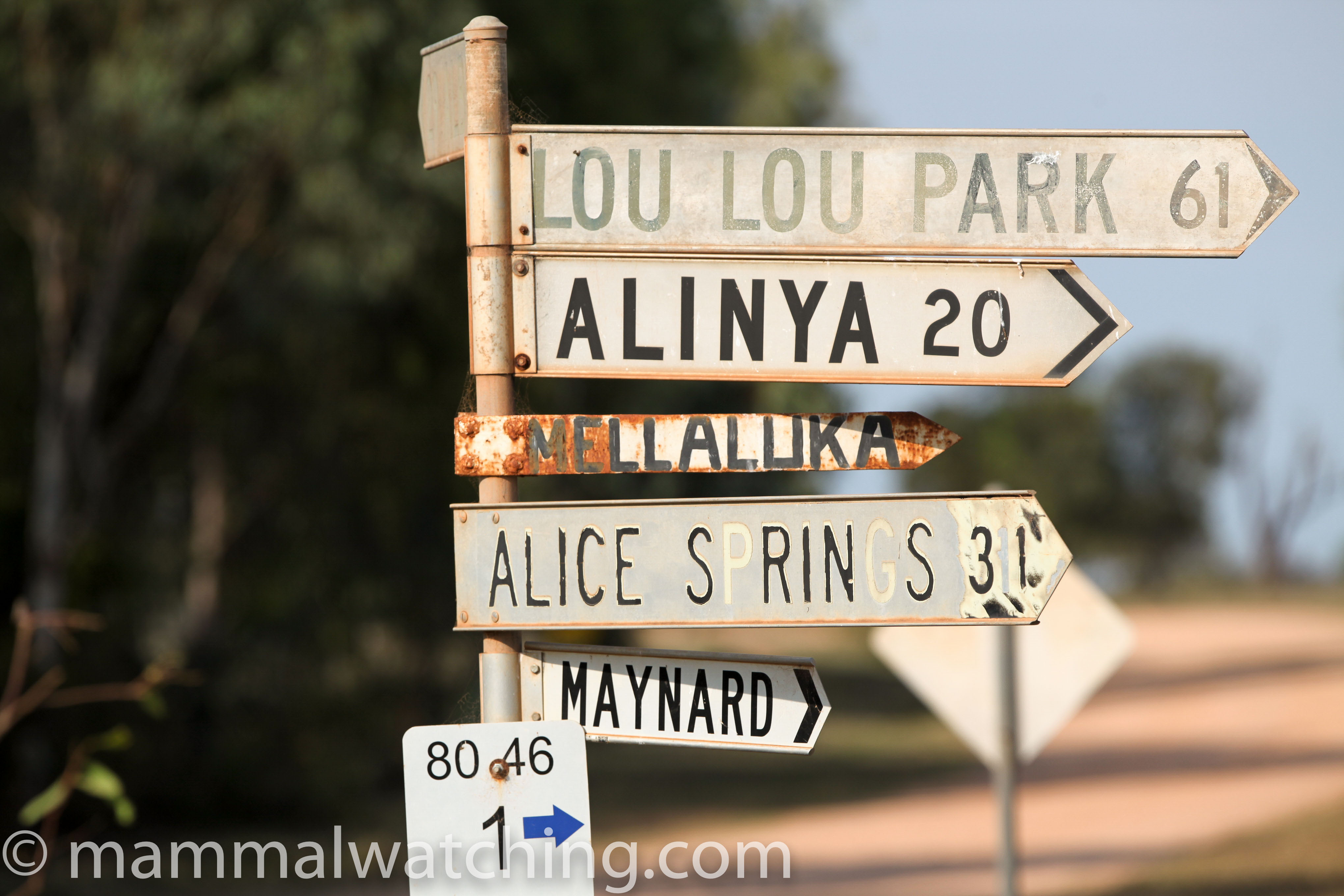
Outback Queensland
Queensland probably offers Australia’s best mammal watching and is one of the world’s great ecotourism destinations. The state has some good rainforest which differs considerably in the fauna it houses – the Atherton Tablelands and the Cape York Peninsula in particular each have several endemic species. There is plenty of drier forest too and this quite quickly gives way to desert. Many species are easier to see in Queensland than further south. Queensland is also, I reckon, the most Australian bit of Australia, whatever that means …. I guess I mean, its hot, diverse, beautiful and full of adventure and characters.
South East Queensland
Brisbane is a great place to see Black Flying Foxes with a very large camp on Indooroopilly Island close to the Brisbane CBD. If you visit the area near the Indrophilly Island Golf Club at dusk you can see tens of thousands of animals leaving the camp. They are also easy to see around the CBD, just after dusk is a good time to look. I have also seen Squirrel Gliders in state forest close to downtown Brisbane.
Mount Glorious in the Brisbane suburbs is a nice patch of rainforest that is a well known spot for birding. I saw a Long-nosed Potoroo here in the mid-morning. It is also a good place to see Subtropical Antechinus (there are no Brown Antechinus here) and I saw one here at sunset in August 2018, along the entrance road to Mount Glorious Getaways.
Lamington National Park on the Border Ranges (the border with New South Wales) has possibly the longest mammal list among any park in Australia. I can think of no other parks where you can see as much in a few days. Probably the best area for mammals is around the O’Reilly’s Lodge, a luxurious hotel that is well clued up on the wildlife. In January each year they run a mammal week. It is usually led by Ian Gynther from the Queensland Parks and Wildlife Service. Ian is immensely knowledgeable and through a combination of skill and stamina usually gets the species count up into the high 30s/low 40s. It is essentially a full blown fauna survey with small mammal and bat trapping, spotlighting and day time searches for the local mammals. I took part in 2001 and 2002 and over the two years we saw Platypus (O’ Reillys have a hide overlooking a small dam where this species is easy to see), Echidna, Yellow-footed Antechinus, Northern Brown Bandicoot, Long-nosed Bandicoot, Common Brushtail Possum, Short-eared Brushtail Possum, Koala, Sugar Glider, Squirrel Glider, Greater Glider, Common Ringtail Possum, Long-nosed Potoroo, Red-legged Pademelon, Red-necked Pademelon, Eastern Gray Kangaroo, Red-necked Wallaby, Whiptail Wallaby, Black Flying Fox, Gray-headed Flying Fox, Little Red Flying Fox, Fawn-footed Melomys and Red Fox. And we caught Brown Antechinus, Pygmy Planigale (Planigale maculata), Eastern Chestnut Mouse, Eastern Horseshoe Bat, Chocolate Wattled Bat, Eastern False Pipistrelle, Golden-tipped Bat, Little Bent-winged Bat, Common Bent-winged Bat, Gould’s Long-eared Bat, Large Forest Bat, Eastern Forest Bat, Australasian Water Rat, Australian Bush Rat, Australian Swamp Rat and Pale Field Rat. Wow! Most species were seen on both trips. In the late 1990s they were catching Hastings River Mice here. I wasn’t lucky but they were caught again in 2006 and 2007. Some hard to see bats have also been recorded recently including Eastern and Greater Broadnosed Bats. Check the O’Reilly’s website for recent trip reports.
Donnybrook near Caloundra is home to the rare and beautiful False Water Mouse (Xeromys myoides) whose habitat has largely been built over by beach front development along Queensland’s Gold Coast. I spotlit one animal near its nest mound in Bullock Creek Conservation Park. The nests was the size of a termite hill and I walked past is several times before realizing it was a nest (I was looking for something smaller).
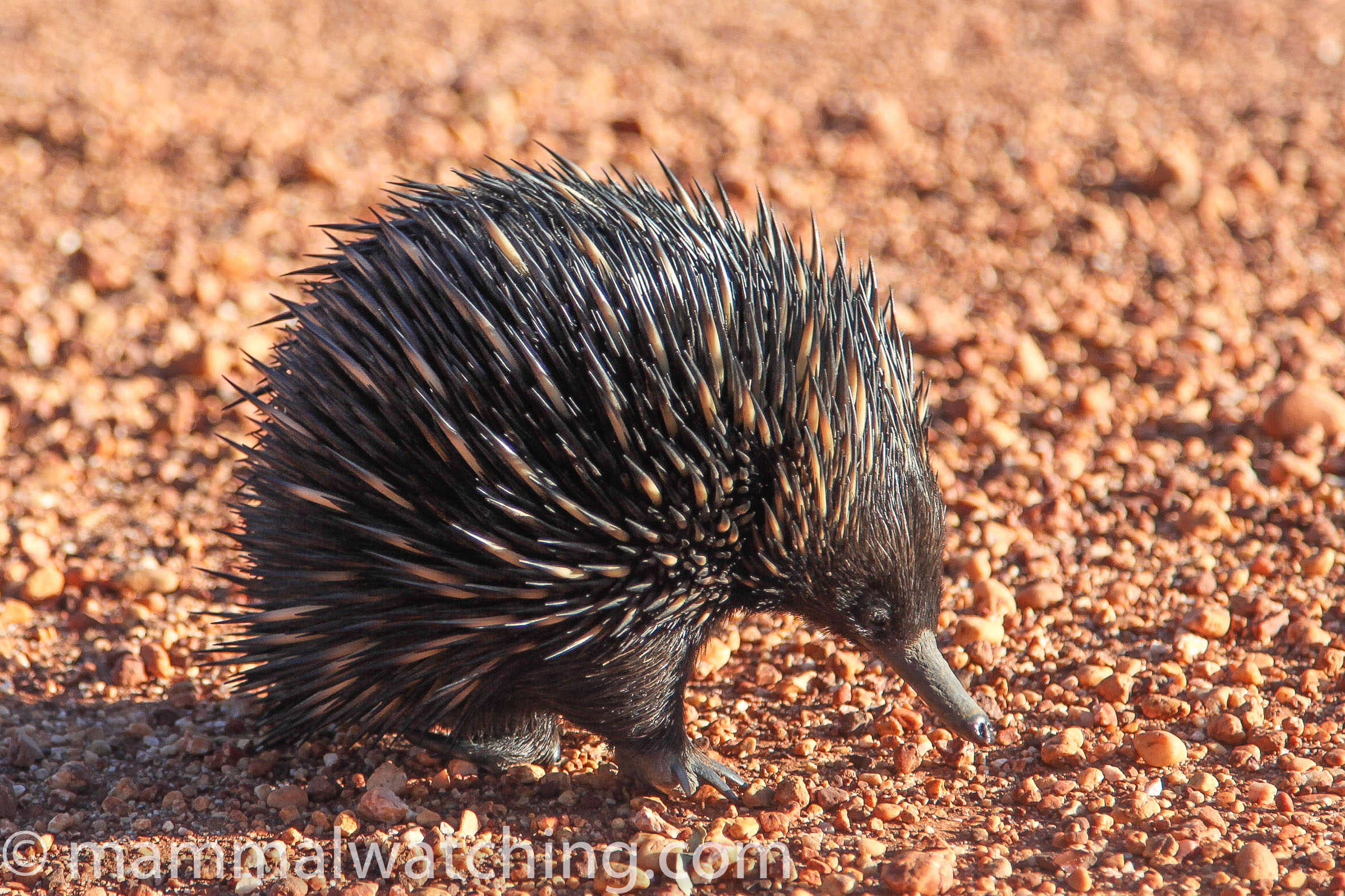
Short-beaked Echidna, Tachyglossus aculeatus
Towoomba is a couple of hours inland from Brisbane and the change in habitat is dramatic. The small town of Perserverance, about 40km north of Towoomba and near Crow’s Nest National Park, is probably the best place to see Brush-tailed Rock Wallabies in Australia. A colony live along the dam wall just out of town and are easy to see in the late afternoon (and doubtless the early morning too). I’ve done some bat surveying around Towoomba. Ravensbourne National Park is a good spot to catch Northern Long-eared Bats (Nyctophilus bifax) and we got Gould’s Long-eared Bats here too.
Southwood National Park, a few hours south-west of Towoomba, is another good place for bats and was the only time I’ve been trip lining to catch them (trip lining involves stringing fishing line over the surface of a dam – the bats hit the line, drop into the water and can be grabbed when they swim to the sides). In an evening trip lining and harp trapping there in March we got several Inland, Little and Intermediate Broad-nosed Bats (the latter species not yet formally described but is usually called Scotorepens parnabyii), Little Pied Bats, Inland Freetails and Gould’s Long-eared Bats. We didn’t catch Greater Long-eared Bats though it is a good spot for them and we may well have seen a few hit the harp trap but avoid capture. There were feral pigs here too.
Noosa is better known for its restaurants but I was surprised to see a Koala here in 2009 in the National Park. They are pretty common apparently.
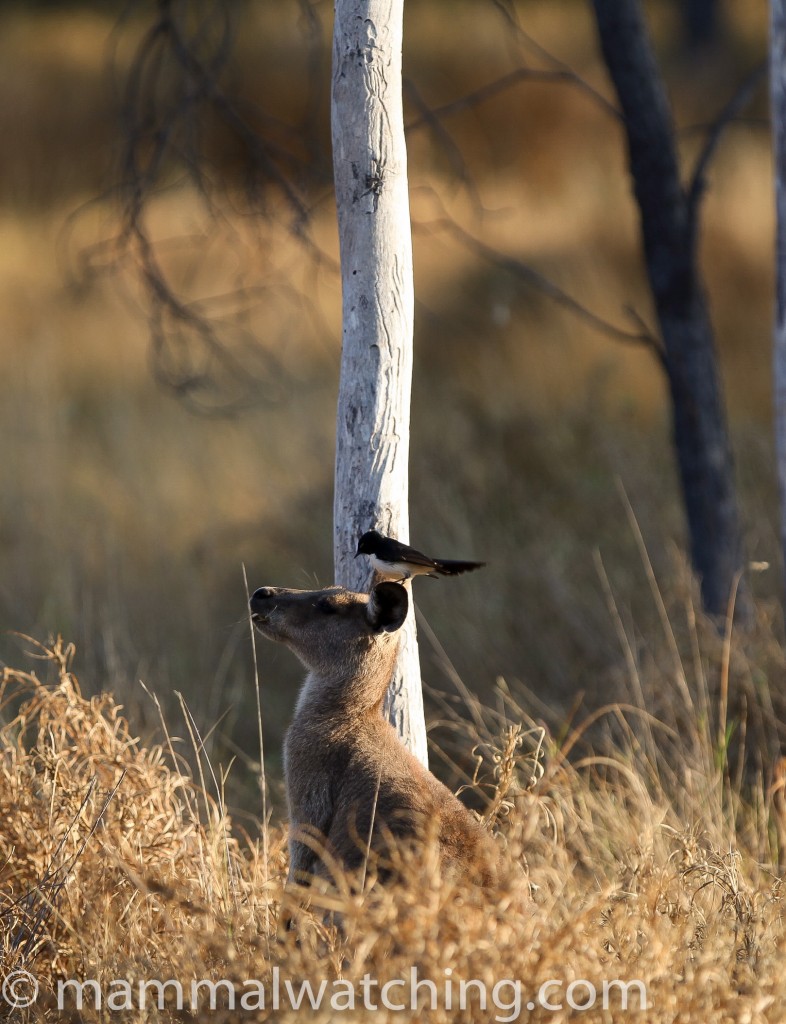
Eastern Grey Kangaroo, Macropus giganteus
The Central Cost: Gladstone To Townsville
Gladstone Harbour is a good place to look for the newly (in 2014) described Sahul Humpbacked Dolphins, especially early in the morning.
Westwood (near Rockhampton) has Herbert’s Rock Wallabies on the rocky hill just west of the township of Westwood: the hill is between the township and junction with the main highway major junction and is on he right hand side of the road when traveling from Rockhampton. This is private property but if you ask in the town I suspect the owner won’t mind you having a look.
Mount Etna Caves National Park just north of Rockhamton is well known for its Ghost Bats but they are hard to see unless you can arrange special access. In the summer it was easy to see thousands of Little Bentwing Bats that roost in the caves. After dark there are plenty of Unadorned Rock Wallabies around the car park near the caves.
Mount Jim Crow National Park east of Rockhampton on the road to Yepoon is another place to look for Unadorned Rock Wallabies.
Taunton Scientific Reserve near Dingo is a couple of hours drive from Rockhampton and the site of the last known population of the beautiful Bridled Nail-tailed Wallaby. This species was thought extinct for several years but rediscovered when a local fence contractor was reading a magazine article about extinct wildlife and saw pictures of the wallabies he regularly saw around Taunton. The reserve is closed to the general public but the Queensland Parks and Wildlife Service were good enough to take me there. I saw plenty of the Bridled Nailtails as well as Black-striped Wallabies, and Rufous Bettongs.
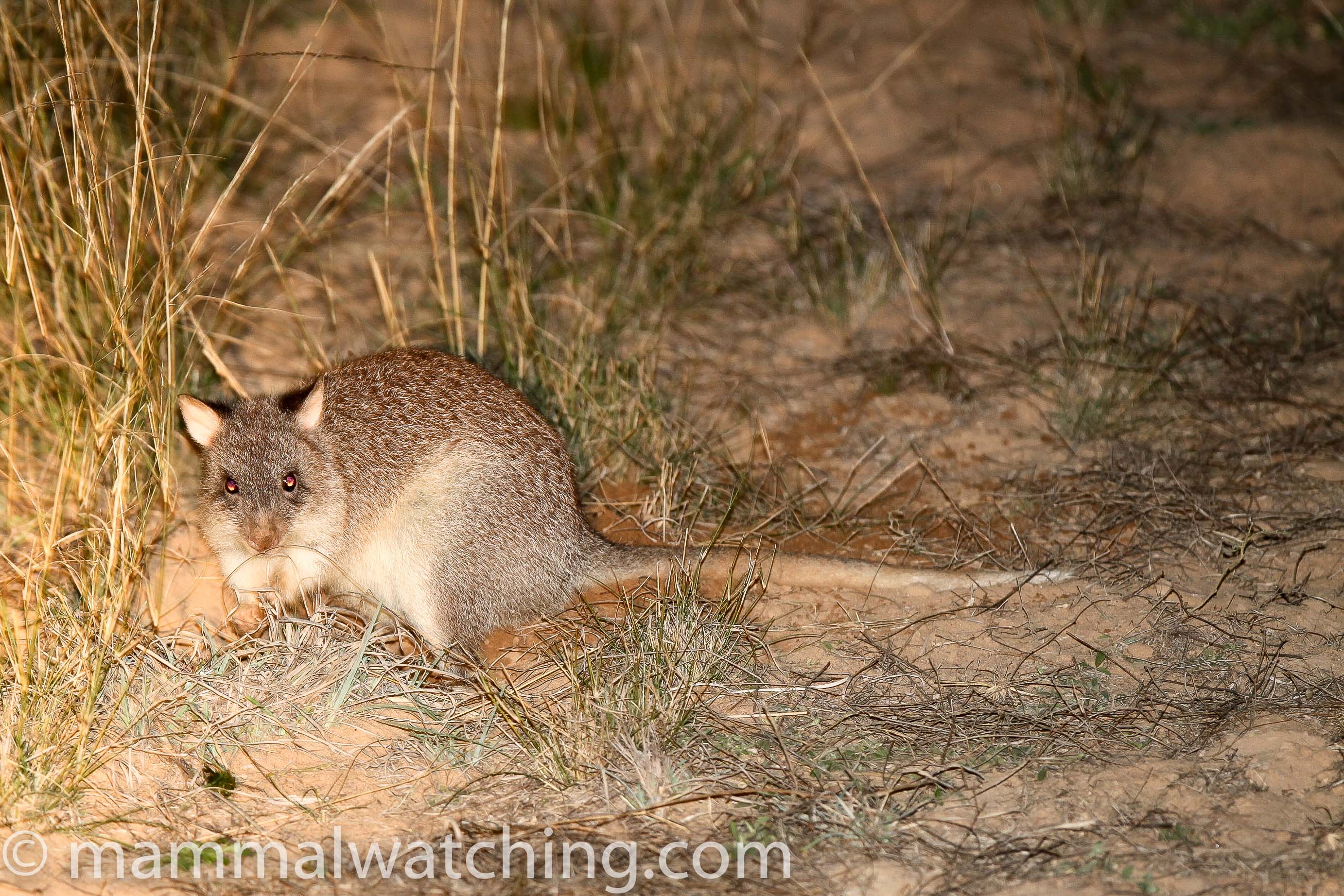
Rufous Bettong, Aepyprymnus rufescens
The Blackdown Tablelands National Park near to Taunton is pretty quiet. I set 5 elliot tramps in a grassy patch of forest bordering the campsite here (before I realized the live mammal trapping in Australia needs a permit) and caught 4 Common/Pygmy Planigales as well as a Sugar Gilder caught in a trap on top of a fallen tree. I spotlit a Yellow-bellied Glider here too.
Airlie Beach is the best place to see Proserpine Rock Wallabies, a species that is both rare and hard to see because it lives in rainforest. But they are fairly easy to see on the slopes of Mount Lucas in Airlie Beach. The drive up the hill – Lucas Heights -is flanked by some expensive houses (indeed a local nickname for the road is the “Stairway to Heaven”) and the wallabies can often be seen grazing along the road side after dark (quite late in the evening is probably the best time to look once the road is quiet). I saw several in the garden of a house on Mount Lucas which the wallabies regularly visit for food. The local parks and wildlife service might be able to help.
Inkerman Station, south of Townsville is supposed to be good for Spectacled Hare Wallabies. You’d need to talk to the owners who can advise on whether they have been seeing them recently and that would partly depend on how long the grass is.
Magnetic Island is a short ferry ride from Townsville. Allied Rock Wallabies are common near the harbour. I took the 6am boat over and saw about 30 on the rocks – being fed by the local garbos (bin men or garbage collectors). On the way back there was a Sahul Hump-backed Dolphin at Townsville Harbour.
Townsville – the Hervey’s Range Road which runs out of Townsville is a good place to look for bats in the culverts that run under the road. I saw what was probably a Hoary Wattled Bat a few km’s up the road though didn’t get a good enough look to be certain. I saw Eastern Cave Bats in culvert number 39 too. Further up the road and near the top of the range there is an abandoned railway tunnel where thousands of Little Bentwing Bats roost. Black Flying Foxes are common in the town.
About 2.5 hours inland from Townsville, Bluff Downs Station is home to feral Chital Deer. Its a nice place to say and during a night’s stay I also saw Allied Rock Wallabies, a Rufous Bettong, Black-striped Wallabies, Eastern Gray Kangaroos and a Black Flying Fox.
Far North, Further North And Really Far North Queensland
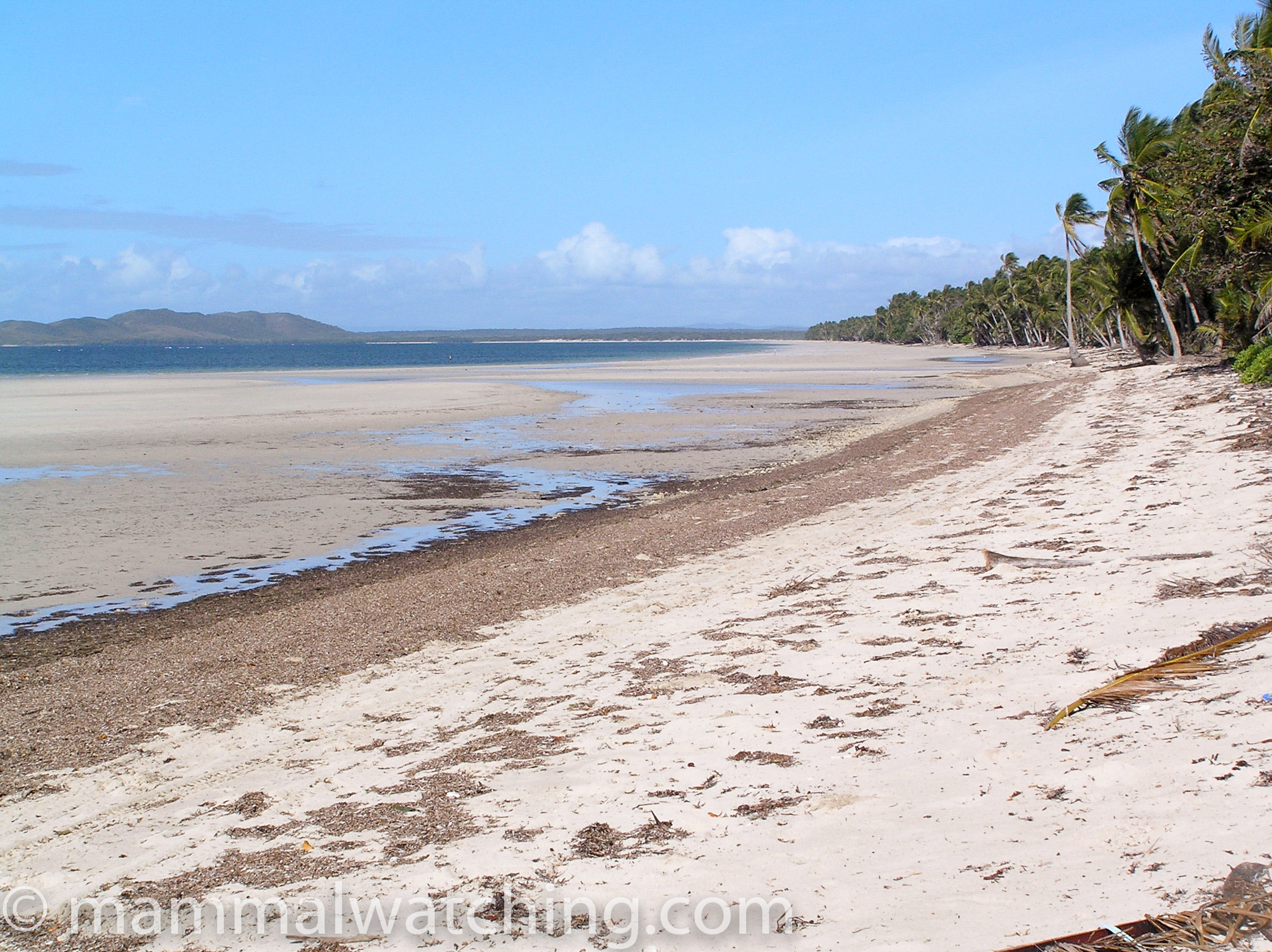
Chill Beach, Iron Range
Although the area north of Townsville likes to call itself Far North Queensland, a quick glance at a map shows this is something of a misnomer. Townsville is a bit north of central Queensland, it is hardly North Queensland and certainly not the Far North. From Brisbane to Townsville its 1400km. It is another 1100 kilometres north from Townsville to the tip of Cape York.
Paluma is a lovely little settlement on the top of the range inland from Ingham. It is surrounded by rainforest but a few kilometres into the mountains the ecotone changes very quickly to dry forest. The Ivy Cottage Tea Gardens in town are well known for the Paradise Riflebirds they attract to the bird feeders (and scone plates on the tables). Late in the day Rusty Antechinuses can sometimes be seen feeding here. I’ve seen Giant White-tailed Rats, Long-nosed Bandicoots, Black Wallabies, Red-necked Pademelons and Bush Rats in the surrounding rainforest. A few kilometres into the dryer forest in Hidden Valley you can find Eastern Pebblemound Mice. Their mounds are indistinct but I suppose there would be a chance to spotlight them – I helped trap some here in 2002.
When driving from Paluma towards the Hidden Valley keep a look out for a large hollow tree on the right hand side of the road, a couple of hundred metres along the first stretch of dirt road. Eastern Horseshoe Bats roost inside and are apparently sometime joined by Large-eared Horseshoe Bats. Similar species live in some old mine workings just off the road as you first enter the village. I found the mine entrance once but couldn’t find it again. The locals would know I guess.
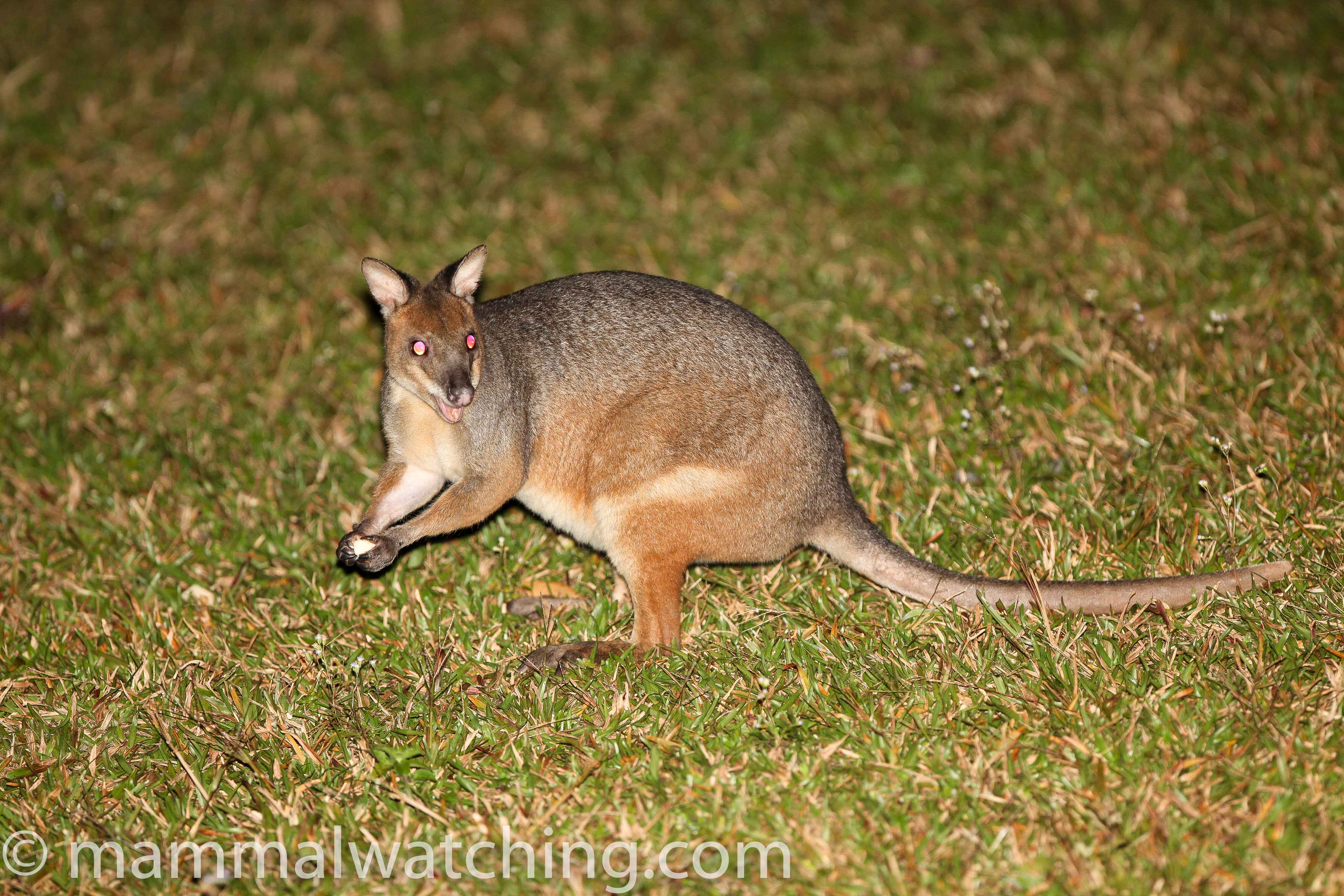
Red-legged Pademelon, Thylogale stigmatica
Ingham is a pleasant town just off the tourist circuit. John Young, wildlife filmmaker and a bit of a legend, lives here. I spent an evening with him looking for Mahogany Gliders along the roads behind Ingham. I think we heard one coming out of a nest hollow along the road to Wallaman Falls, just at the end of the section of dirt road. Any flowering gums in this area would be worth looking in. I eventually saw a couple of animals living in a nest box on a farm nearby. It was interesting to see Diadem Leafnose Bats hunting from the telegraph wires along the roads behind Ingham. They hang on the wires to ambush their insect prey.
Mount Claro, near Ingham, is home to Sharman’s Rock Wallabies. Mount Claro itself is along the Mount Fox road, about 8kms after the crater and a little school house there is a sharp drop off in the road and Mount Claro is a jagged hill top on the left hand side. I saw the rock wallabies at dusk. Mount Claro is private property so it could be good to ask for permission to walk a little way onto the land to look for the wallabies (the property is part of Kilcloonie Station and the owner lives about 10km down the road). I saw a Rufous Bettong on the drive back at night to Ingham.
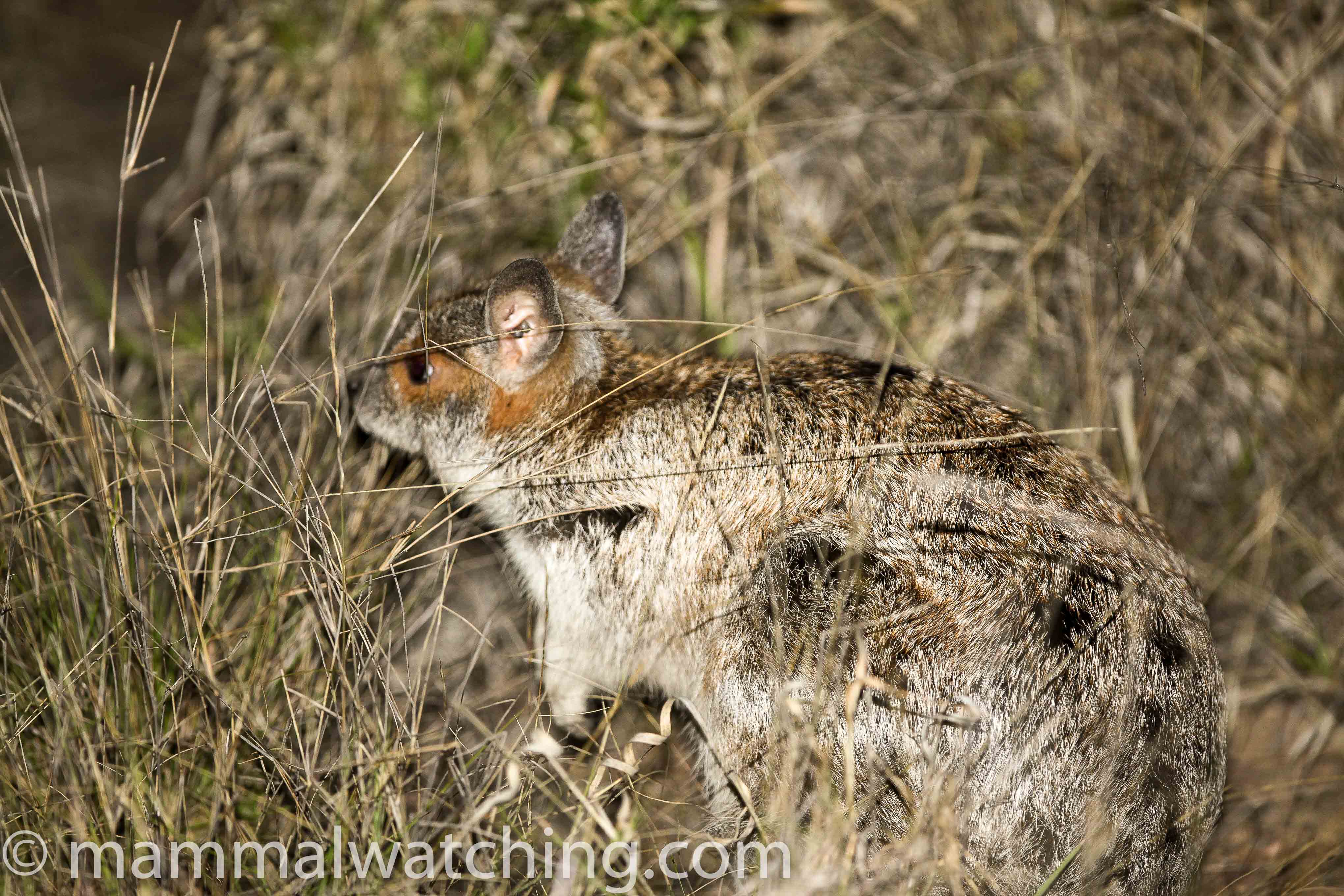
Spectacled hare-wallaby, Lagorchestes conspicillatus
Ingham to Cardwell is prime Mahogany Glider habitat and any of the mixed eucalypt forest along here is worth checking for them. Look for flowering gums (not stringybarks, more bloodwoods and mahoganies and eucalyptus platyphylla) and check out any unlocked forestry tracks. Barratt’s Lagoon about 5km south of Tully and then a few kilometres east is supposed to be another good spot for the gliders.
Bramston Beach Caravan Park is between Cairns and Townsville. There is a small cave on the edge of the rainforest at the back of the caravan park which is home to several hundred Dusky Leaf-nosed Bats (Hipposideros ater).
Cairns is a great place for bats and in 2002 the Australian Bat Society’s biennial conference was here so he local experts showed us around. Coastal Sheathtail Bats (Taphozous australis) are a rare species but a good site for them is a sea cave about 40 kilometres north of Cairns near the Hartley Creek Crocodile Farm (near Port Douglas) on the Bruce Highway. After you cross the creek in front of the farm you can turn right to Wangetti beach and park after a few hundred metres. A ten or 15 minute walk north up the beach brings you to a rocky headland, which is directly under a lookout area on the Bruce Highway. There is a deep fissure into the rocks and Coastal sheathtails were roosting in there. Access at high tide could be tricky! Little Northern Free-tailed Bats (Mormopterus loriae) are quite common in Cairns we saw a few while we were bat detecting in Cairns Botanic Gardens (apparently this species is particularly common around streetlights in Townsville) and we saw a Northern Mastiff Bat (Chaerephon jobensis) here too. Dusky Leafnosed Bats and Eastern Horseshoe Bats are common in various caves and mine shafts in the area with Large-eared Horseshoe Bats occasionally turning up too. Spectacled Flying Foxes usually roost around Cairns and you should see them flying around. Black Flying-foxes were around in August 2011 too.
Boat trips to the Great Barrier Reef and Coral Sea sometimes see cetaceans. I saw a pod of Spinner Dolphins and a Dwarf Minke Whale during a 4 day dive trip to the Coral Sea in September 1999.
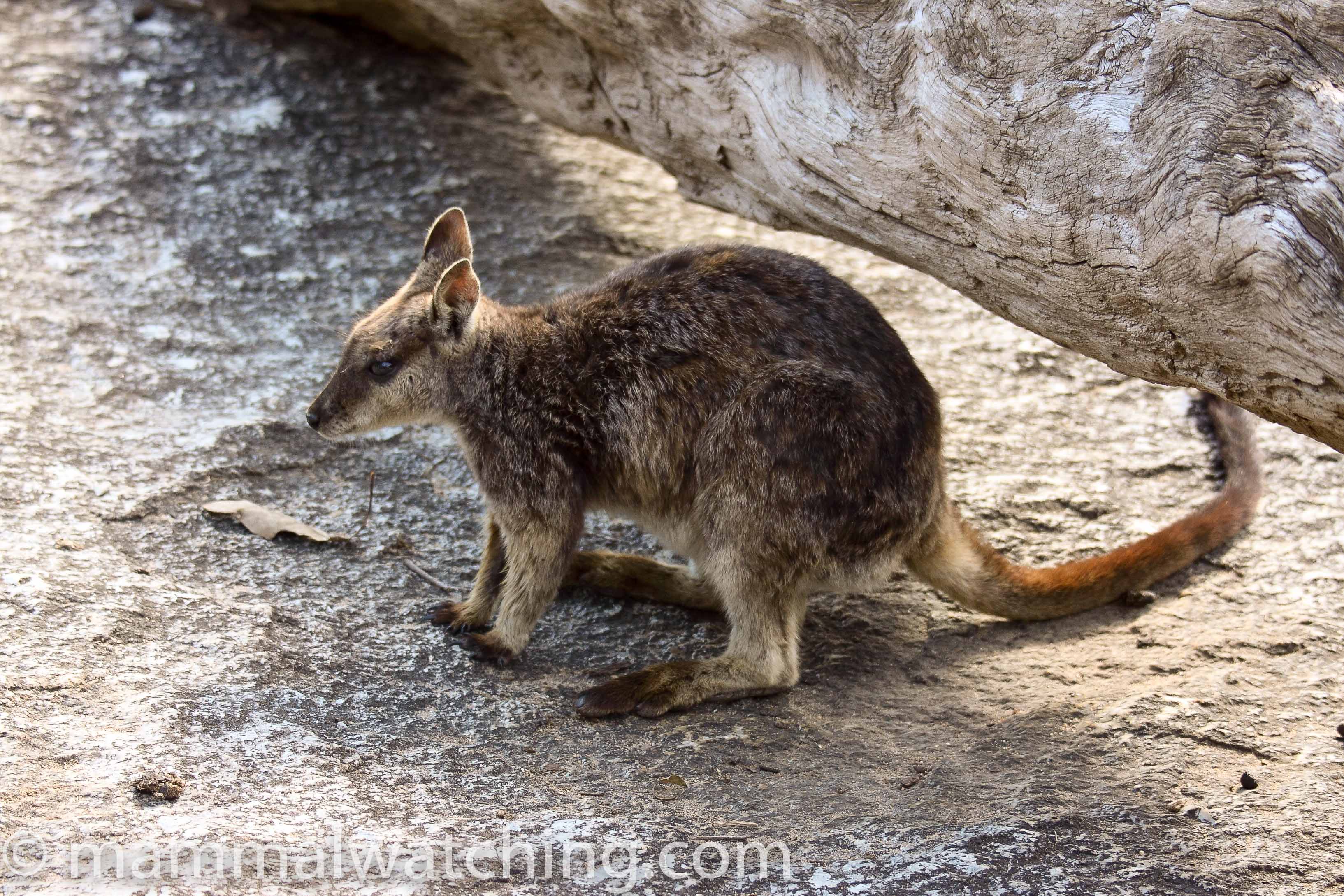
Mareeba Rock Wallaby, Petrogale mareeba
Mareeba half way between Cairns and the Atherton Tablelands has dry forest that is home to Black-footed Tree Rats, which are rare in Queensland but still fairly common in the parts of the Northern Territory such as the forest around Darwin (or at least they were common there before the Cane Toads arrived). Although the rats are generally rare, there was a population explosion in 2001 at a large Macademia plantation just south of Mareeba. I saw about 10 tree rats in an hour’s spotlighting there, along with a couple of Masked Owls. Driving around the roads near Macademia farms might be productive. Mareeba Rock Wallabies are easy to see in Mareeba Gorge.You can even buy food for them. Agile Wallabies are also common in the area.
The Atherton Tablelands are an hour and a half’s drive inland from Cairns, and home to a number of species found nowhere else. Unlike other rainforest in the wet tropics, the forest around Atherton remained rainforest during a period of climate change several thousand years ago which saw much of the other rainforest drive out. The rainforest expanded again but several possum species had already become locally extinct. These relict species still survive on the tabelands. There are several good sites for mammal watching and even small patches of rainforest can be good for species like Tree Kangaroos.
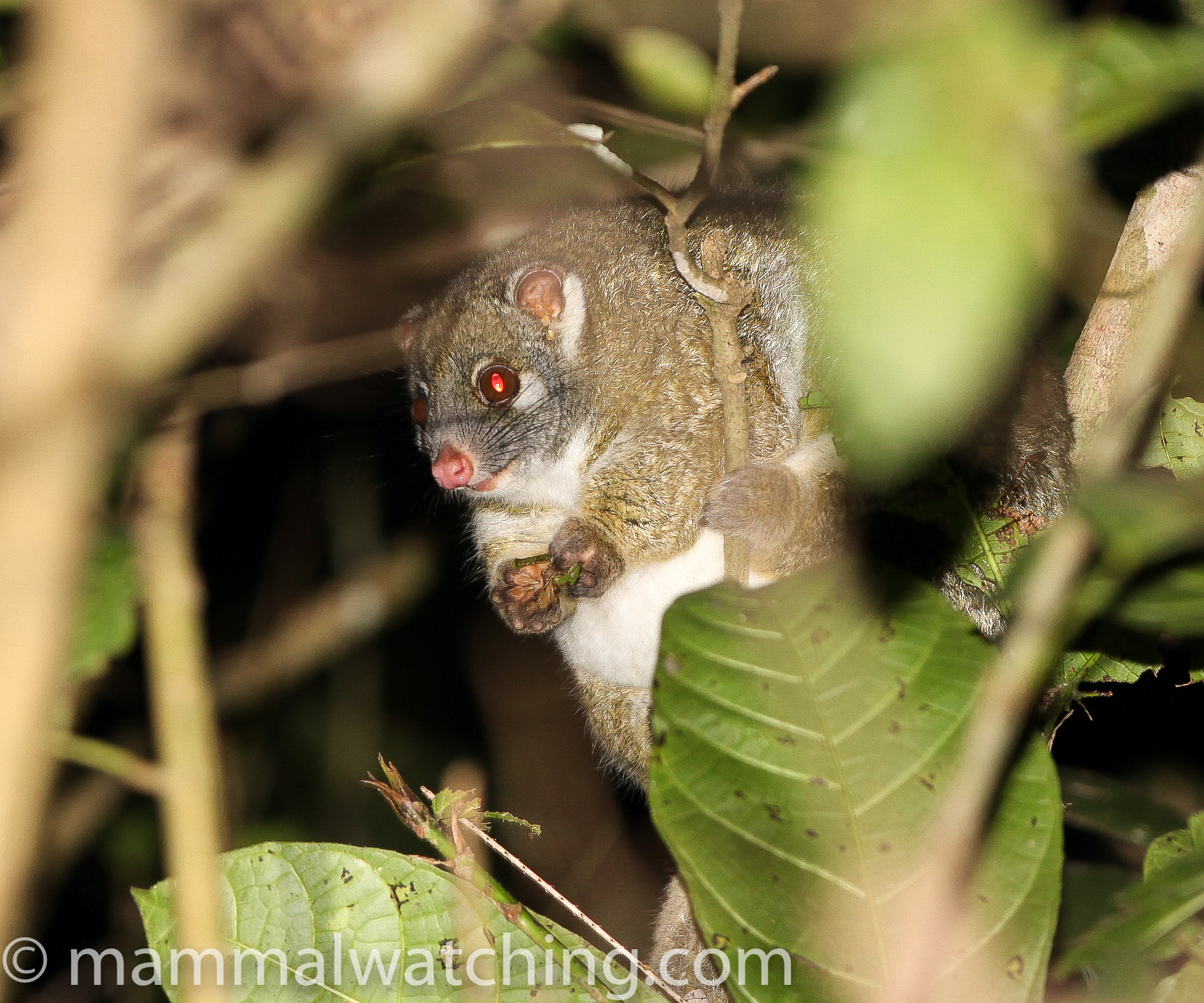
Green Ringtail Possum, Pseudochirops archeri
Mount Hypipamee National Park can be very good for spotlighting. Green, Herbert River and Lemuroid Ringtail Possums all quite common as are Coppery Brushtails. Lumhotlz Tree Kangaroos are also reported from here and it is one of the few places from where Long-tailed Pygmy Possums are sometimes spotted: indeed I finally got a very unsatisfactory view of what must have been this species in Aug 2011.
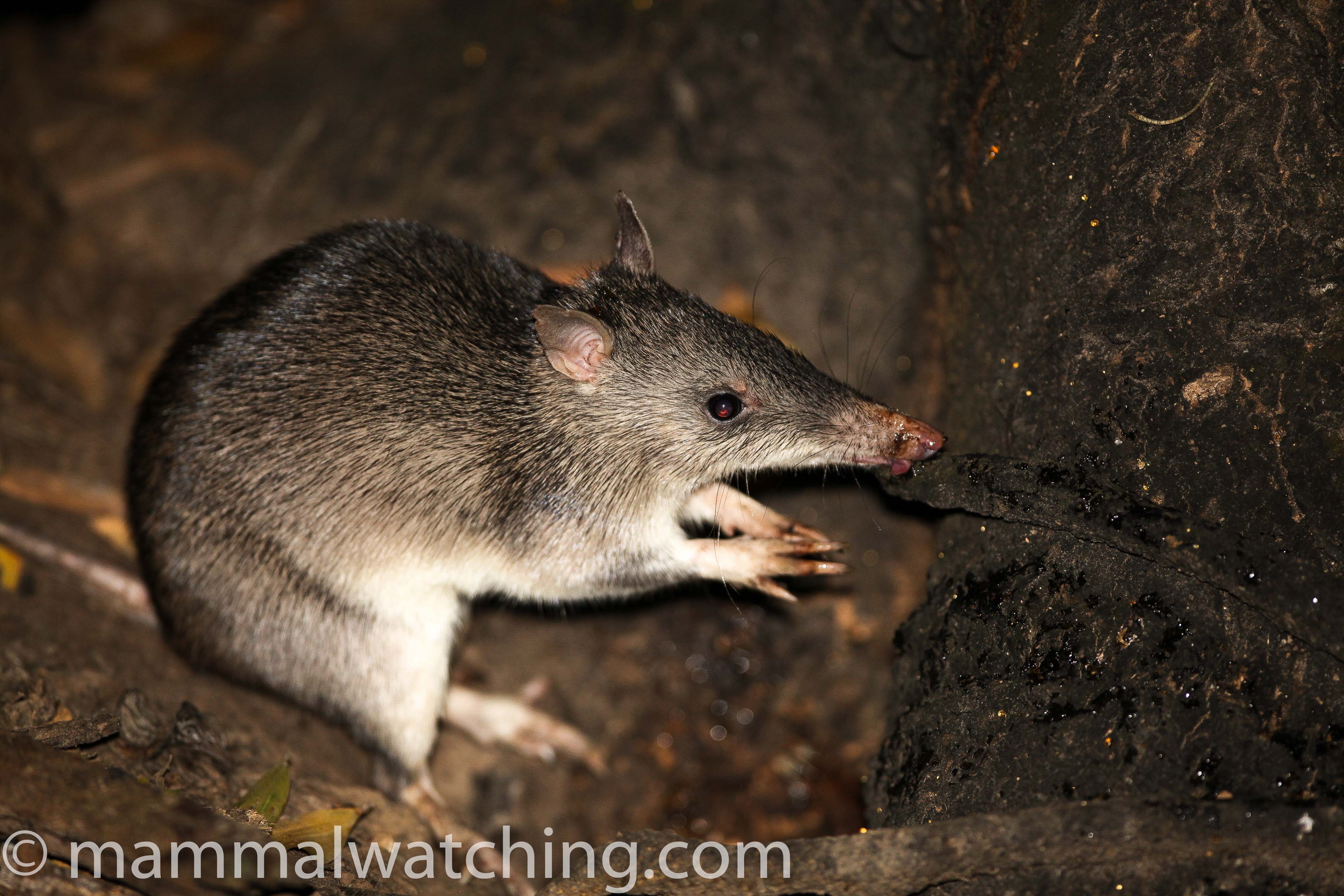
Long-nosed Bandicoot, Perameles nasuta
Lake Eacham and Lake Barrine are good places to spotlight. Northern Brown and Long-eared Bandicoots are common around here and often seen on the road at night. Massive Giant White-tailed Rats can sometimes be seen on the ground or heard feeding in trees. Brushtail Possums (the north Queensland coppery species), Red-legged Pademelons are common in some areas and Sugar Gliders were easy to see at the Chambers Wildlife Lodge which is quite a good place to base yourself to see a range of mammals. They feed Sugar Gliders and Pademelons here and in 2011 I saw Long-nosed Bandicoots visiting the honey, and was told White-tailed Rats and Striped Possums are regular visitors too. Musky Rat Kangaroos are quite common around both lakes and the lodge in the daytime and I also saw a Yellow-footed Antechinus in the mid morning on the shores of Lake Barrine.
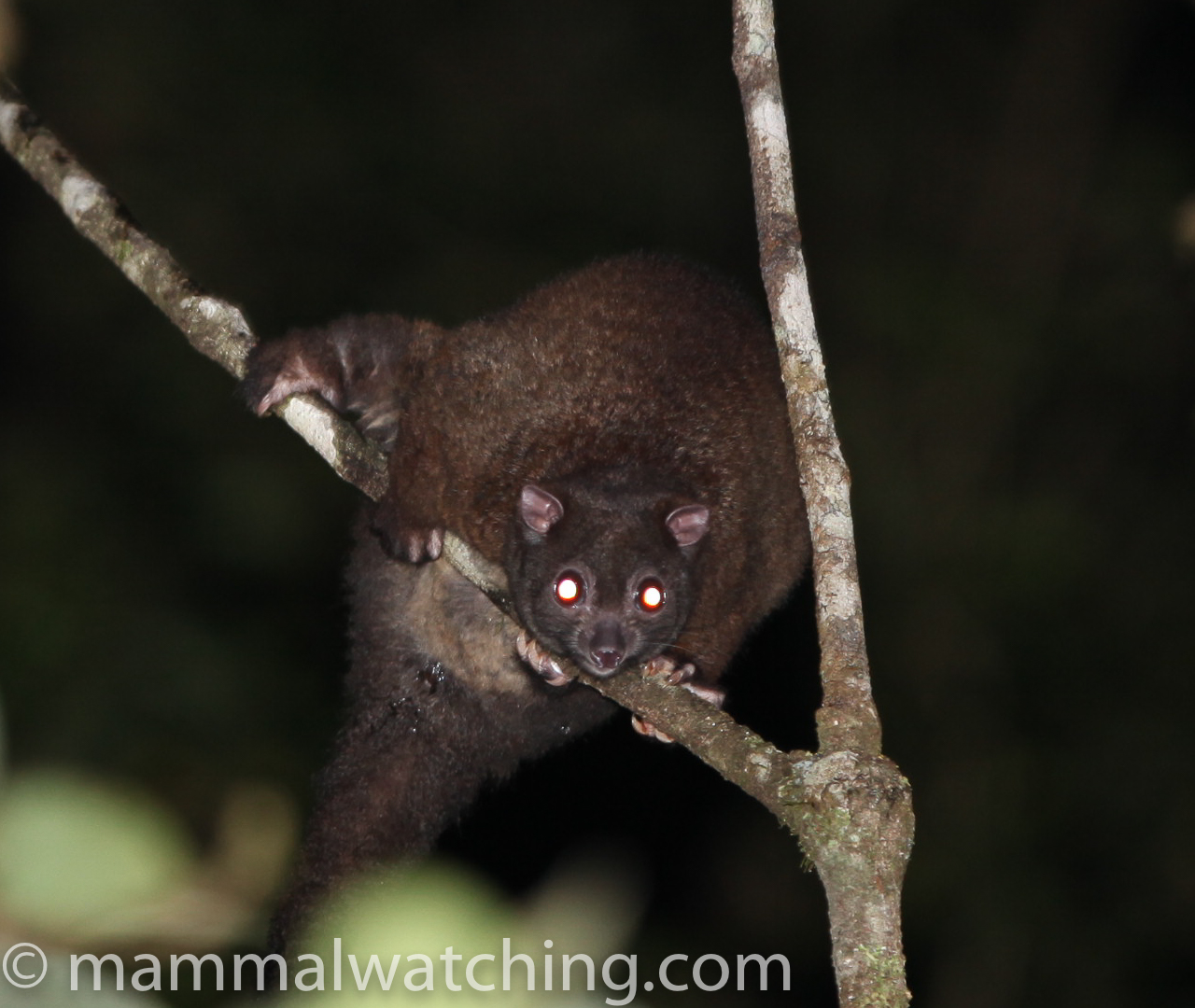
Lemuroid Ringtail Possum, Hemibelideus lemuroides
Wait a While tours are based in Cairns and run wildlife trips to the tablelands and the Daintree. In 1999 I took a trip with them and they were excellent. During an evening with them on Mount Baldy we picked up Lemuroid Ringtail and Green Ringtail Possums as well as a Lumholtz Tree Kangaroo and Greater Gliders.
Fur n’ Feathers rainforest treehouse accommodation near Atherton is another spot where Tree Kangaroos are often seen. The website boasts an absence of flies, mosquitoes and crocodiles. I would be surprised if that extends to an absence of leeches!
Alan Gillanders,who runs Alan’s Wildlife tours based on the tablelands, has some more uptodate advice. In late 2007 he recommended Wongabel State Forest for Lumhotz’s Tree Kangaroos and sometimes Striped Possums. Tree Kangaroos are also often around the Curtain Fig and and sometimes along Peters Creek at Yungaburra. He also recommends the Tarzali Lakes Fish Farm, south of Malanda, as a very good spot to see Platypus. Numbers of Musky Rat Kangaroos plummeted in 2007 but hopefully they will recover.
Mout Bartle Frere is Queensland’s highest mountain. There are two routes to climb it. the easiest, and best for wildlife begins at the end of the Gourka road (follow Lake Eacham road to Topaz Road to reach it). I have spent several evening spotlighting along the start of the trail and have climbed the mountain twice. Giant White-tailed Rats are common, as are Bush Rats. I saw a rare Atherton Antechinus (Antechinus godmani) along the beginning of the trail. The mountain is also home to the very localised Masked White-tailed Rats. Researchers from the government’s CSIRO caught quite a lot here, indeed I was told that higher up the mountain they were probably the most common small mammal. But I have never seen one despite two long evenings spotlighting near the summit. Nor did I see the Tiger Quolls that often hang around the summit campsite. But I did meet about 300 very large leeches and a big sounder of feral pigs. On the way to the Gourka Track you pass a small lookout called Lammins Hill. Masked White-tailed Rats have also been recorded here.
Tinaroo Creek Road on the tablelands is the best spot I know for Northern Bettongs (Bettongia tropica). Try spotlighting in the state forest just past the gate which requires a permit to pass through.
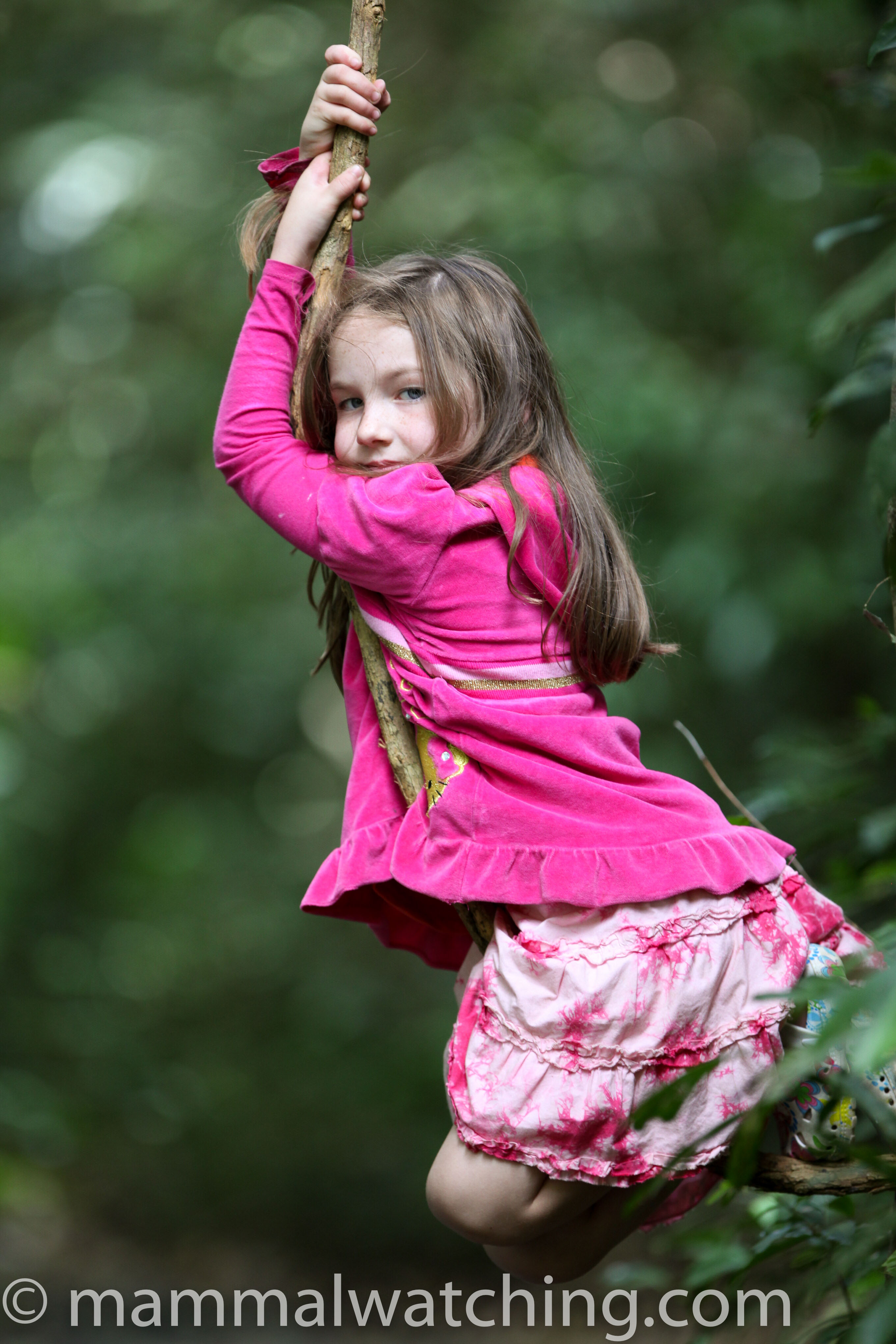
Queensland is great for mammal watching and vine swinging
Mount Lewis near Julatten is another very good patch of forest. In particular, Kingfisher Park, a bird watching lodge at the base of the mountain has a fairly small patch of rainforest around it which is a great place to see mammals including two quite hard to see species – Prehensile Tailed Rats and Striped Possums. I stayed here four or five times and saw the following: Prehensile Tailed Rat (I saw one feeding on Jack Fruit in the orchard, this is a very hard species to find elsewhere although they are apparently seen further north around Shipton’s Flat in the wet season), Striped Possum (seen on three separate occassions at least -this species is not uncommon but quite hard to predict), Green Ringtail Possums (common), Fawn Footed Melomys (very common), Canefield Rat (I trapped one in the edge of the sugar cane adjoining the property), Queensland Tube-nosed Fruit Bat (spot lit in the orchard), and Red-legged Pademelons (which were very common when I first visited in 1999 but which had disappeared in 2000). I also found some Northern Broadnosed Bats roosting under the owner’s car port.
The road up Mount Lewis needs a 4wd but spotlighting along here I have seen Herbert River Ringtail Possums, Daintree River Ringtail Possums, the white morph of the Lemuroid Ringtail Possum, and a Dingo which ran up the hill for a couple of minutes at about 50km an hour in front of my vehicle. Northern and Tiger Quolls are seen sometimes and Long-tailed Pygmy Possums too. Platypus are sometimes seen in the creek at the base of the mountain – try looking from the small bridge.
Ravenshoe is often shrouded in cloud. I saw several Yellow-bellied Gliders in dry state forest near to the town in 1999 – this north Queensland subspecies (aka Fluffy Glider) is endangered. The forest along the road to Tully Falls is excellent for all manner of possums. During a night’s spotlighting along here I saw Herbert River and Lemuroid Ringtail Possums as well as a Long-nosed Bandicoot, Fawn-footed Melomys and Bush Rats. About 20km along the road to Tully Falls you pass Ebony Road (a small track on the right hand side). This is a good area for Atherton Antechinus.
Millaa Millaa near to Ravenshoe is also worth a look. At a friend’s property here I saw Lemuroid Ringtail and Coppery Brushtail Possums as well as Diadem Leafnosed Bats hunting.
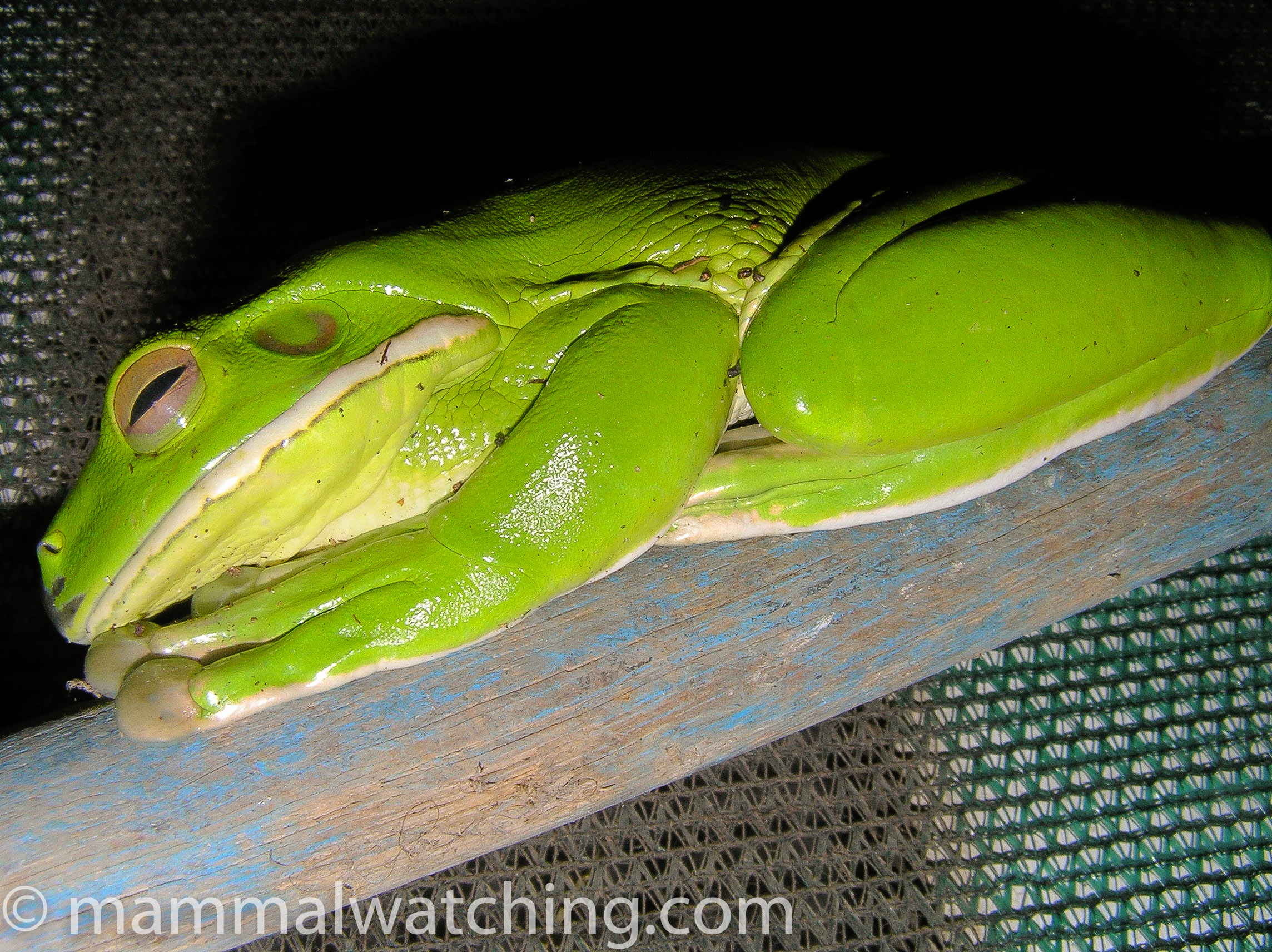
Tree Frog
The Daintree is popular with backpackers and day trippers from Cairns. The forest is quite impressive but there are fewer mammals than in the tablelands. It is good for bats though and a couple of hours bat catching around The Bat House at Cape Tribulation caught a Queensland Tube-nosed Fruit Bat, Least Blossom Bats, Little Bentwing Bats and best of all a Flute-nosed Bat (Murina florium). This species is probably commoner than what people used to think but is still very rarely trapped – Hugh Spencer who runs the bat house said that it was only the fourth he had seen in 11 years. Spectacled Flying Foxes often roost near the village and I saw plumes flying along the river at dusk (ask where a good viewing spot is depending on the location of that bat camp). Some operators run spotlighting cruises along the river. I saw a Striped Possum during one of these trips as well as many Blossom Bats, which you can recognise from their size and that they have eyeshine. Its likely that you will see both Least (Macroglossus minimus) and Eastern Blossom Bats (Syconycteris australis) although I was told that Macroglossus were the commoner species in the mangroves. I saw a Northern Brown Bandicoot visiting athe deck of the Heritage Lodge restaurant in 2011.
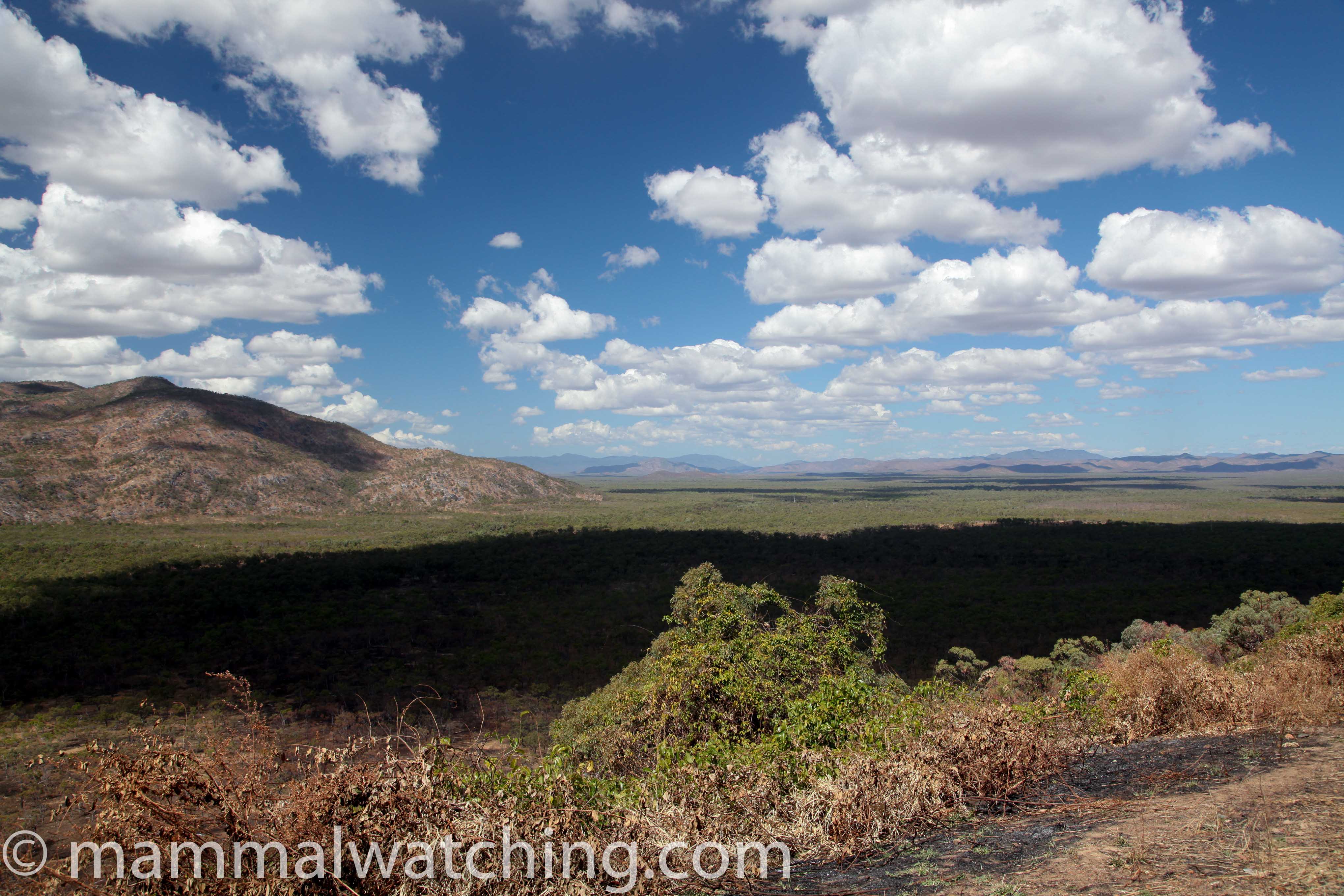
The road to Cooktown
Cooktown is, I reckon,where North Queensland proper begins. The inland road from Cairns passes through Mount Carbine and the road culverts here are a place to look for Eastern Cave Bats (I saw some in a 3 pipe culvert about 10km north of Mount Carbine). In Cooktown itself I have caught Grassland Melomys (in the grassy woodland near Treviathan Creek).
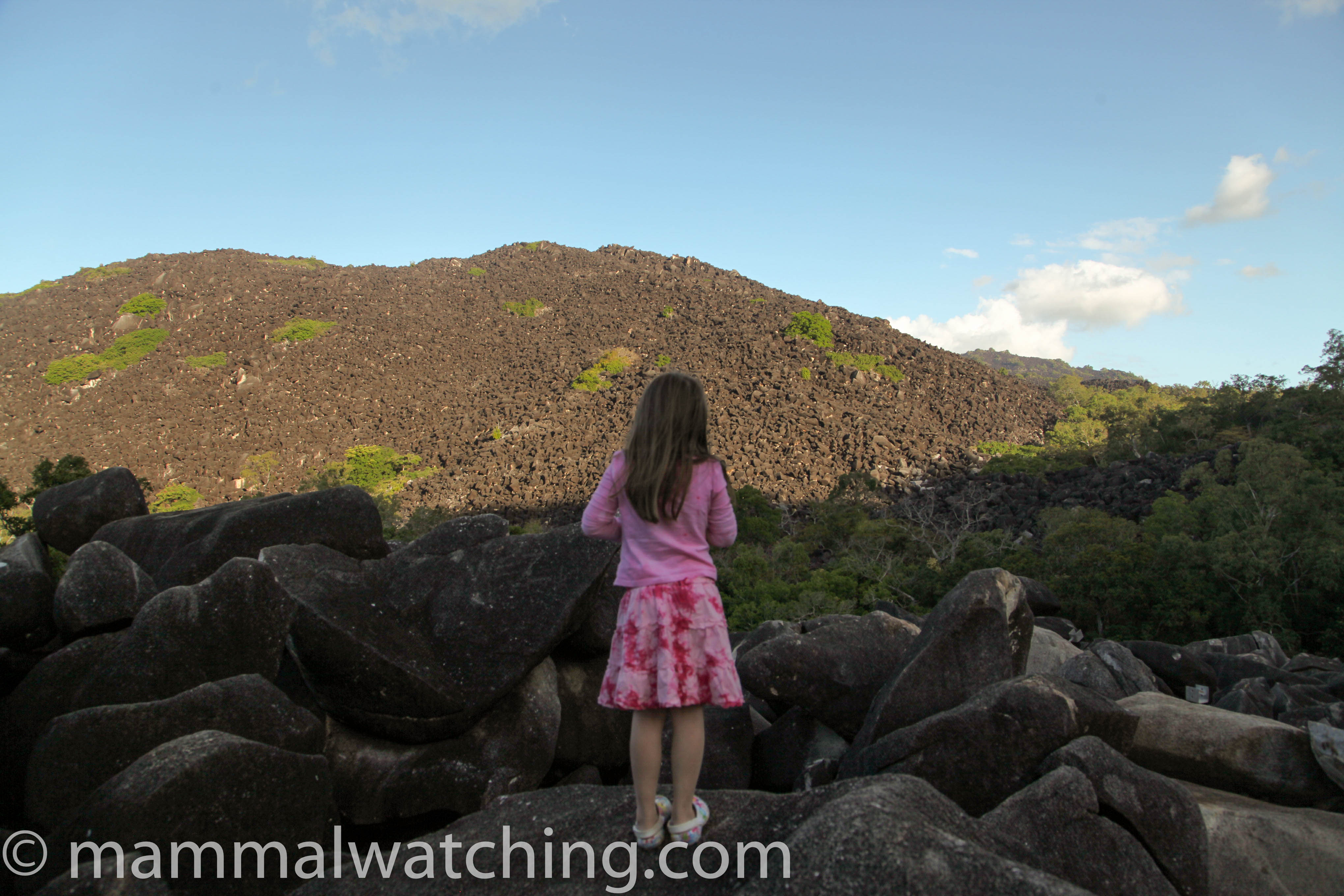
Black Mountain
Black Mountain, just south of Cooktown, is a bizarre mountain made of boulders. It is the type locality for Godman’s Rock Wallabies. The animals had almost disappeared in the 1980s but I saw some here in 2000. They were still reported to be here in 2011. Scan the rocks at dusk from the information bay and viewing platform. If you cannot find them there then try south of Lakeland: I was sent a photo of a dead Godman’s Rock Wallaby along Highway 81, at the James Earl Lookout about 20km south of Lakeland. Ghost Bats live in Black Mountain but I haven’t seen them and the area is an Aboriginal Sacred Site so you are not encouraged to climb into the rocks. I tried ” squeaking” for Ghost Bats here. I have no idea if this works though it could do in theory. I didn’t see a Ghost Bat but a Northern Quoll emerged from the rocks to get a better look at me.
Shipton’s Flat, near Black Mountain, is home to Bennet’s Tree Kangaroos and two brothers, Charlie and Lewis Roberts, who have lived their whole lives in Shipton’s Flat. They know the land and its wildlife like the backs of their hands. They are extraordinary naturalists, and usually happy to take people out to look for stuff if they have some time. You can track them down at the Lion’s Den Pub near Black Mountain (the Lion’s Den is a good place to stay – the basic rooms are a bit dismal but they have some nice safari tents out the back and the occasional Eastern Horseshoe Bat in the bar).
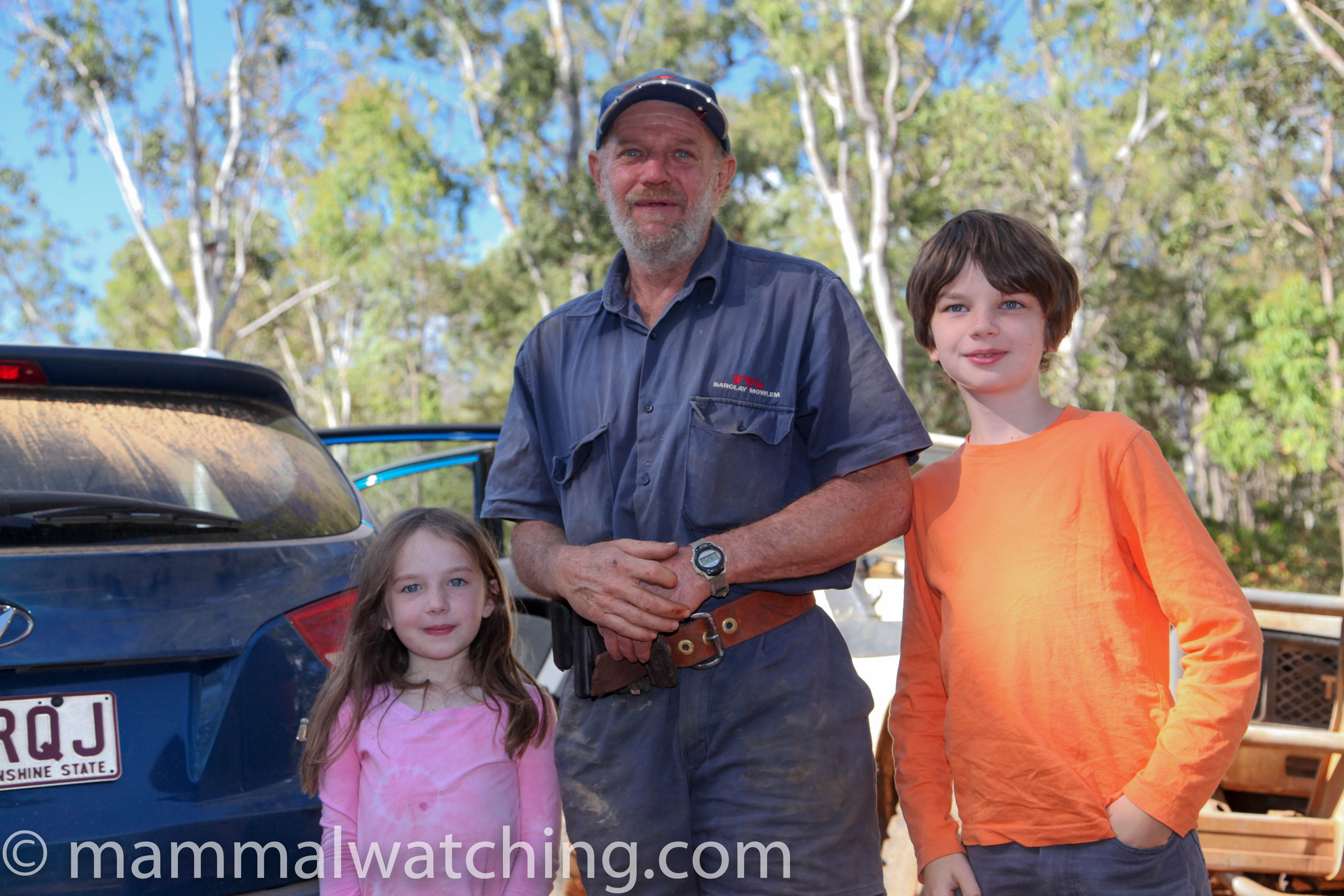
Charlie Roberts and my kids
I always try to meet up with Charlie when I’m there. He has helped researchers and film crews work with Tree Kangaroos and he’s a 24 carat Queensland character with some great stories and a unique delivery style. During my first visit Charlie found me a Bennet’s Tree Kangaroo during the day and a small camp of Spectacled Flying Foxes. I have been spotlighting with him around his property at least 4 times and seen several Striped Possums (this is one of the best places to see this species), Northern Quolls (very common), Fawn-footed Melomys (very common) and a Sugar Glider. In August most years a certain tree on the property is a mass of flowers and often alive with Long-tailed Pygmy Possums and Feathertail Gliders. I’ve visited twice when it was flowering but didn’t see anything.
Charlie is also knowledgeable about the bats in the area. In the old Collingwood Mine near Rossville there are usually plenty of Eastern Horseshoe Bats and I have seen Diadem Leafnosed Bats and, frustratingly briefly, a Large-eared (Queensland) Horseshoe Bat too. I’ve also seen Dusky Leafnosed Bats and Little Bentwings when I have been exploring with Charlie, as well as Antilopine Wallaroos and Agile Wallabies.
Lakefield National Park is predominantly grassland. Agile Wallabies are common as are Little Red Flying Foxes. Northern Nail-tailed Wallabies are a bit harder to see but I saw 3 in the area around Marina Plains station in the north of the park. They are quite common on the air strip by Musgrave River Roadhouse. Check out any of the waterholes with a spotlight and the numerous crocodilian eyeshine will explain why swimming is not a good idea.
Musgrave River is good for Agile and Northern Nail-tailed Wallabies. It is also the most accessible site for Cape York Rock Wallabies. They live on Artemis Station, the entrance of which you drive past on the road into Musgrave (the station is well known for its endangered Golden Shouldered Parrots) and you should ask for permission before you go looking for the wallabies. Take the Edward River Road west out of Musgrave and you’ll see some low rocky hills off to the south. The wallabies live on the hills but they get a bit closer to the road after about 8 or 9 kilometres. I parked the car and walked in. The animals were hard to see – perhaps they are hunted quite heavily and are particularly wary – and I spent a few hours wandering around one evening and the following morning before I saw one. But judging by the amount of rock wallaby shit (which is cigar shaped and distinctive) they are not uncommon here.
Coen is a good spot to break the journey north. Agile Wallabies are common and there are Flying Foxes roosting in town (but I cannot remember which species). Giant White-tailed Rats are in the forest near the river and Northern Nailtail Wallabies were common along the road past the rubbish dump. It is worth checking the culverts under the road on the way into Coen. Along one of the few stretches of tarmac between Coen and Musgrave I saw two Semon’s Leaf-nosed Bat roosting in side by side large metal culverts, the only time I have seen this species.
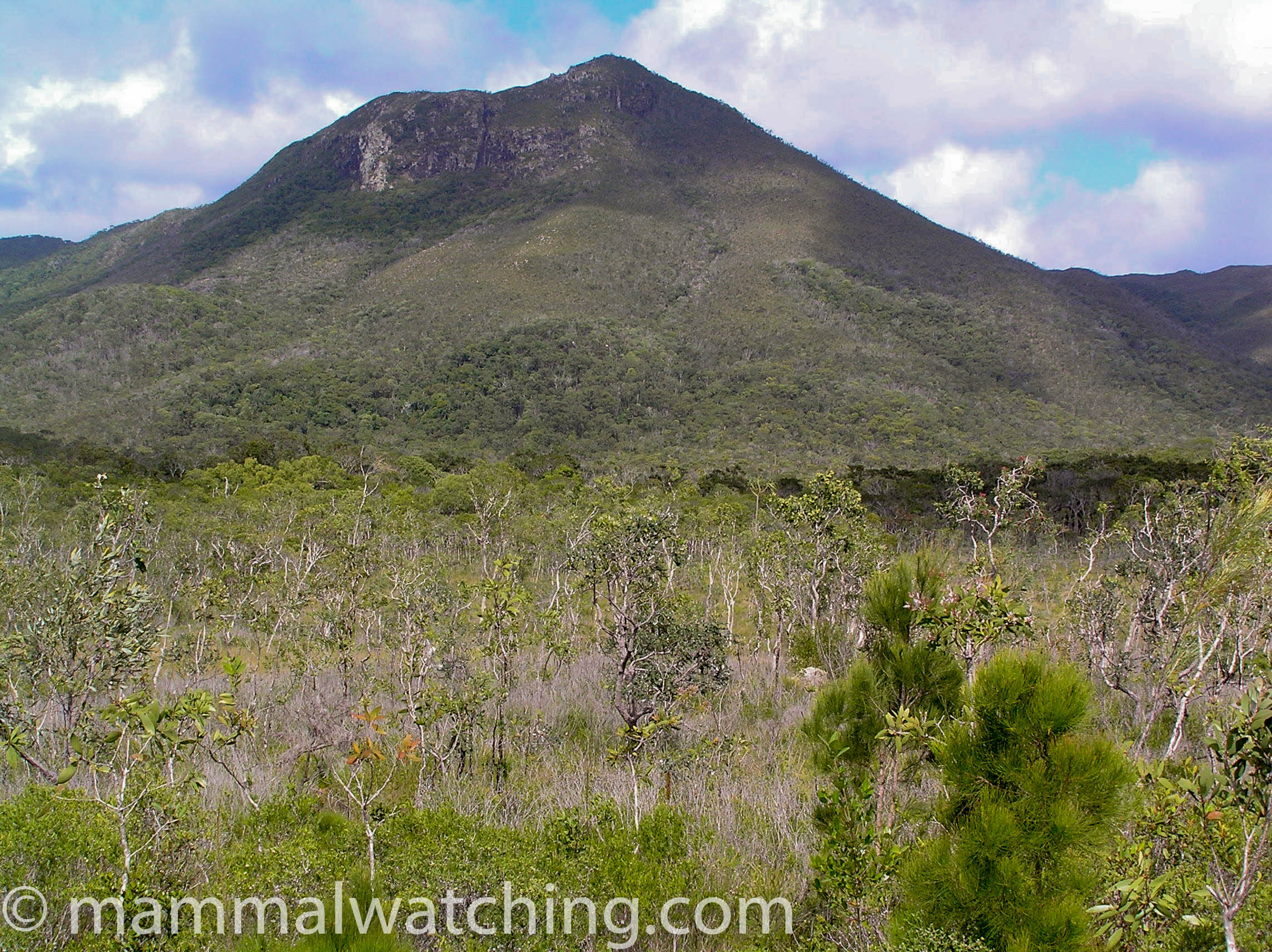
Iron Range
Iron Range is a magnificent melting pot of New Guinea and Australian fauna. Quite a few of the mammals and birds here are not found elsewhere in Australia. The rainforest around the Gordon Creek campsite is as good a place as any to look as is the forest around the Claudie River crossing. Common Spotted Cuscuses are commonly spotted, I saw three of four each night I went spotlighting. Giant White-tailed Rats and Cape York Melomys should also be pretty easy to find. I only saw one (probable) Cape York Rat. There are some good bats here too including Queensland Tube-nosed Fruit Bat (check out fruiting cauliferous figs) and Bare-backed Fruit Bats were quite easy to see – you could generally hear they “whop whop whop” of their wings hitting during flight before you see them. The settlement of Portland Roads is a good place to see these animals where they often feed in some of the gardens. And there are Eastern Horseshoe Bats, Fawn Leaf-nosed Bats and Large-eared Horseshoe Bats living in the gated mine near Gordon Creek campsite (though I couldn’t find the latter, but then I couldn’t get into the mine).
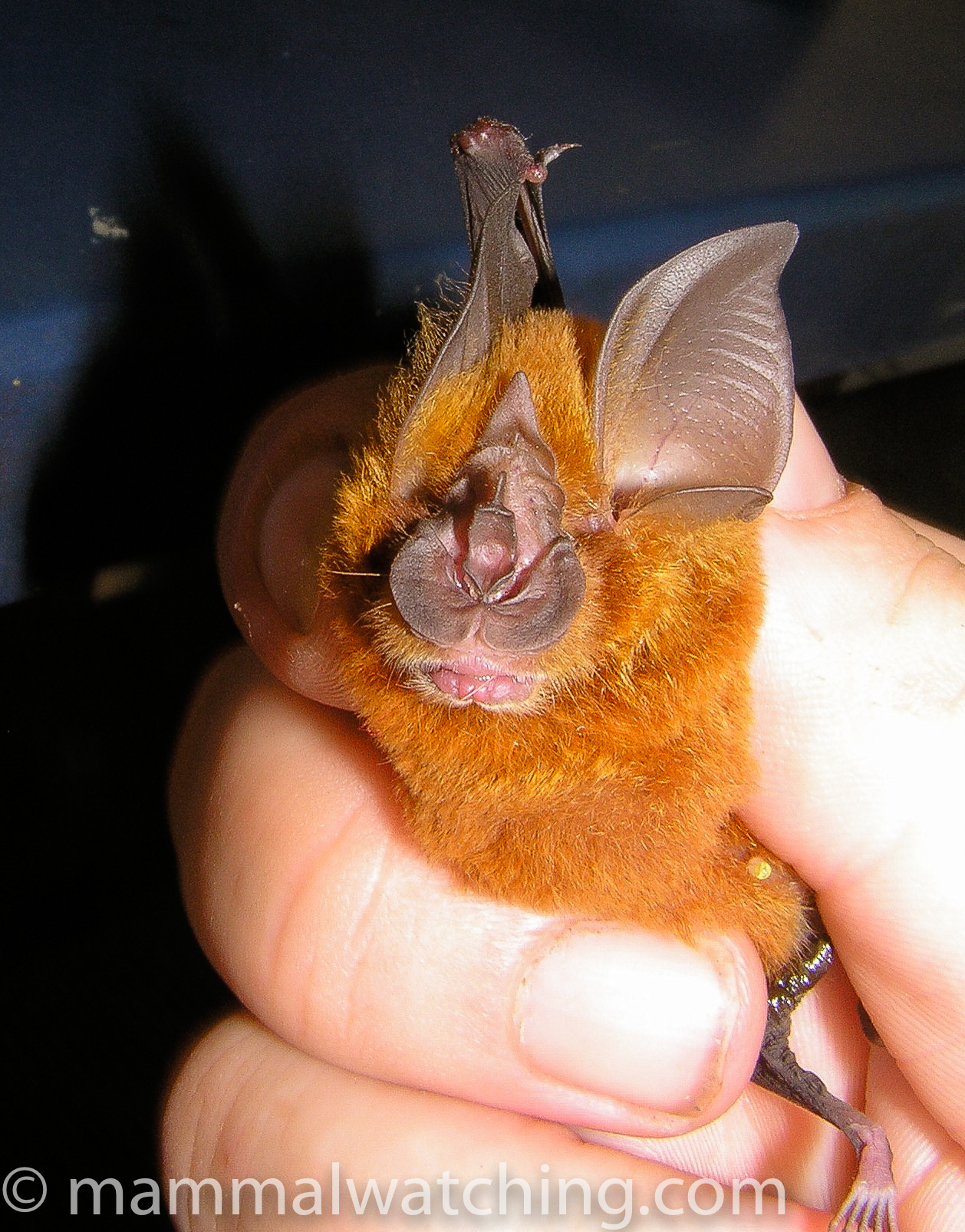
Eastern Horseshoe Bat, Rhinolophus megaphyllus
I was there for 5 nights and missed out on Grey Cuscuses and Rufous Spiny Bandicoots, both uncommon but could turn up anywhere in the forest. Cinammon Antechinuses are fairly common but you need to be lucky. Chestnut Dunnarts inhabit some of the heathland around here but you’d have to be very lucky unless you can find someone doing some pitfall trapping.
Outback Queensland
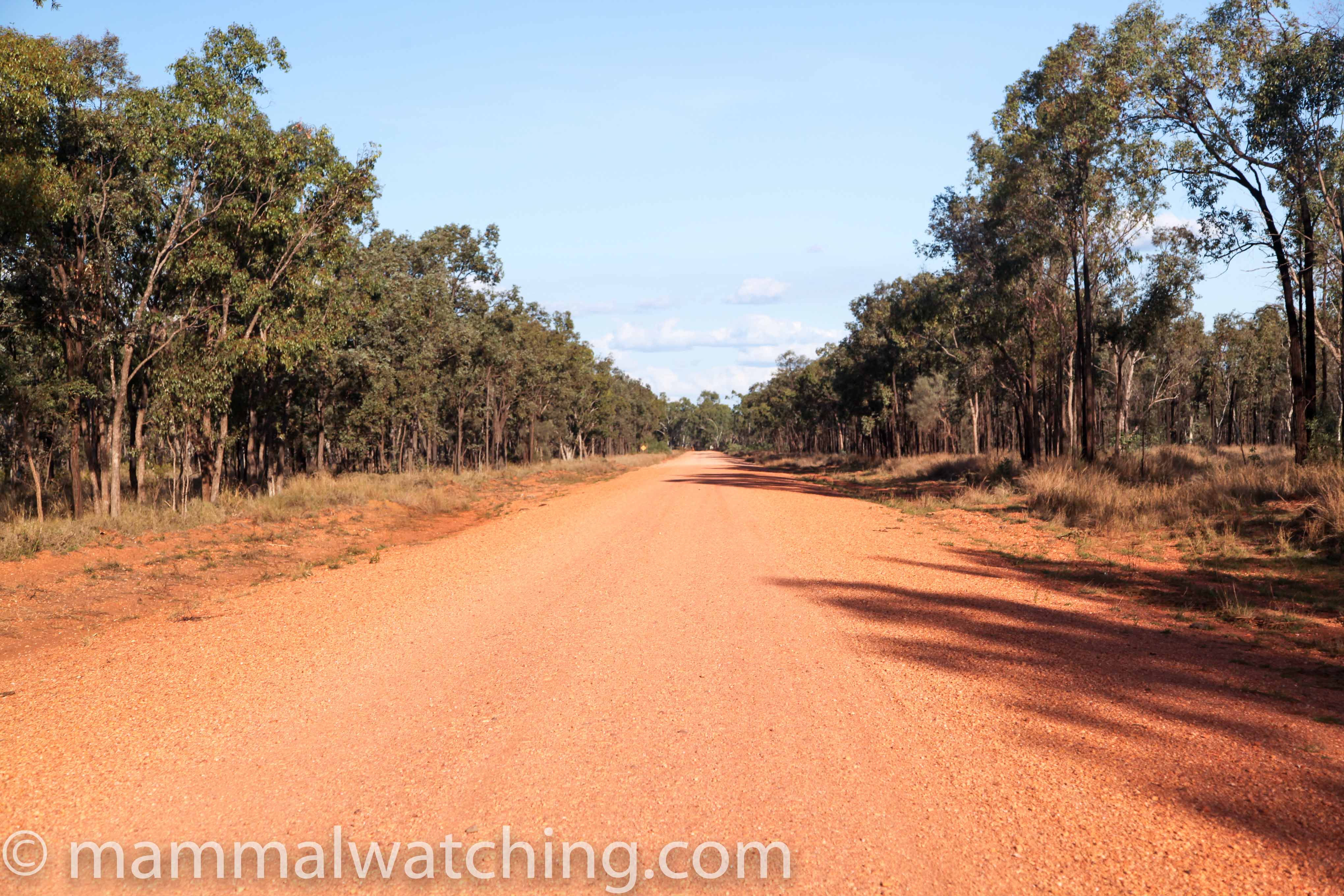
Bedourie, is on the edge of the Simpson Desert. I drove 100km from here to the boundary of the Sandringham cattle station to see Wild Dromedary Camels – there are lots of camels in Australia but they live in remote areas. Despite spotlighting for many hours I didn’t see any Mulgaras or Ampurtas around here although they would be present, as would many other small rodents and dasyurids.
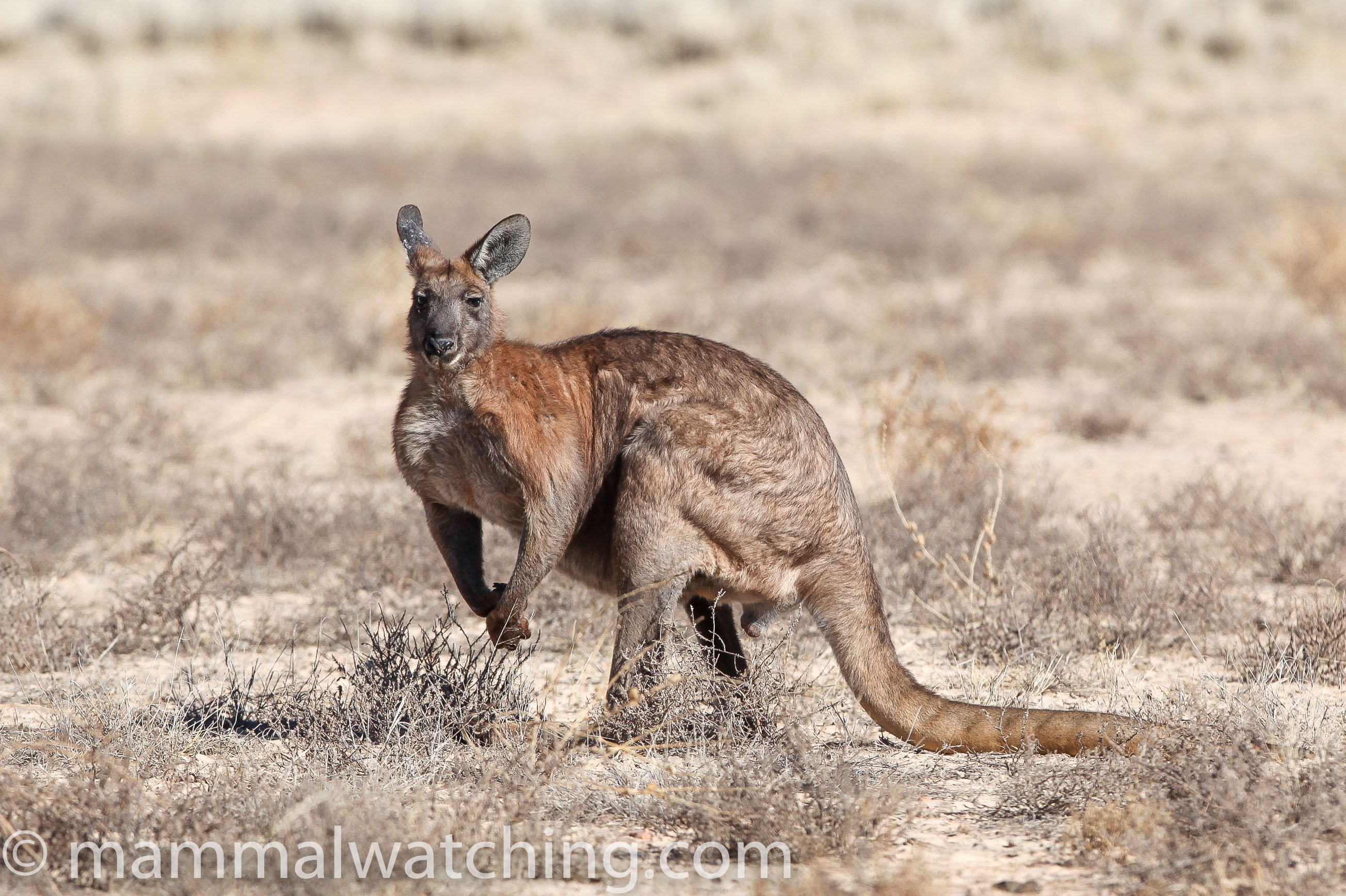
Common Wallaroos, Macropus robustus
Bladensburg National Park near Winton is home to Julia Creek Dunnarts and a few other interesting and hard to find inland species including Forrest’s Mouse and Narrow-nosed & Long-tailed Planigales. It is a wonderful place, though during my first visit in 2004 I only spent a night here and couldn’t find any Dunnarts. One area to look is the Mitchell Grass flats out behind the homestead/visitor centre (interestingly, I was told that fauna surveys have caught the Dunnarts in Elliot traps – Dunnarts are usually hard to trap other than in pitfall buckets). During an evening’s spotlighting I did see a Yellow-bellied Sheathtail Bat fly overheard as well as Red and Eastern Grey Kangaroos and Wallaroos.
I returned for a weekend in September 2011. The good news is that the Dunnarts are still there. The ranger told me they had caught four animals just a fortnight before I arrived (I’m not sure of the trapping effort involved). The bad news is that I didn’t see any small mammals at all during 5 hours spotlighting on foot and from my car over 2 nights focussed on the Mitchell Grass Flats 2 – 3kms behind the Homestead. It was a full moon which presumably didn’t help. I didn’t even see any Long-haired Rats which had plagued fairly recently. The ranger told me they were now in decline but I would “definitely” see a few. Its a beautiful park though and Red Kangaroos and Wallaroos were particularly abundant.
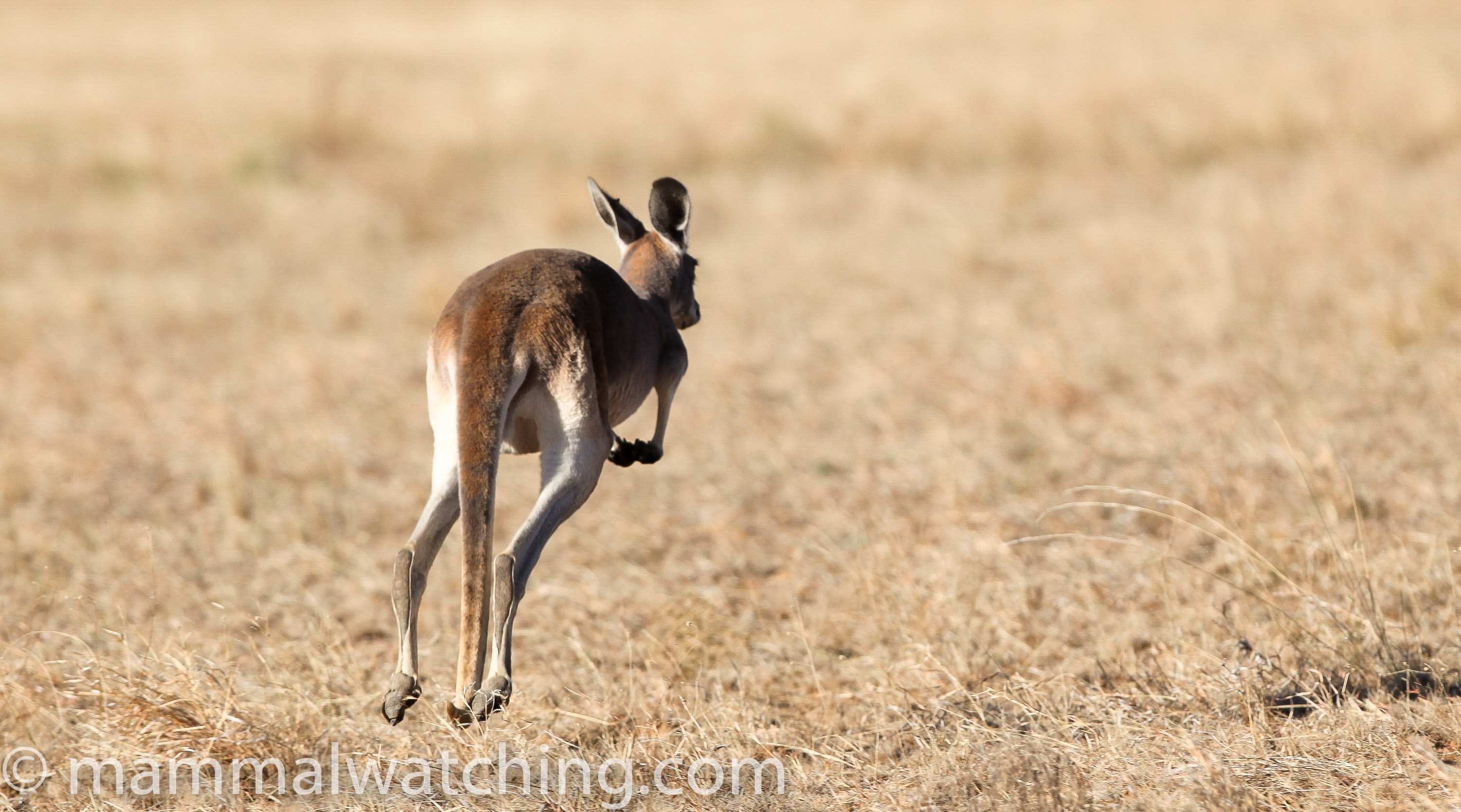
Red Kangaroo, Macropus rufus
The only other mammals I saw were feral Cats and Red Foxes.
Cairns to Hughenden – On the drive from Cairns to Hughenden I saw plenty of Eastern Grey and Red Kangaroos as well as Wallaroos.
Chillagoe National Park, another popular day trip from Cairns is home to several bat species. I saw my first Diadem Roundleaf Bats here along with Troughton’s Sheathtails (Taphozous troughtoni) and Little Bent-winged Bats.
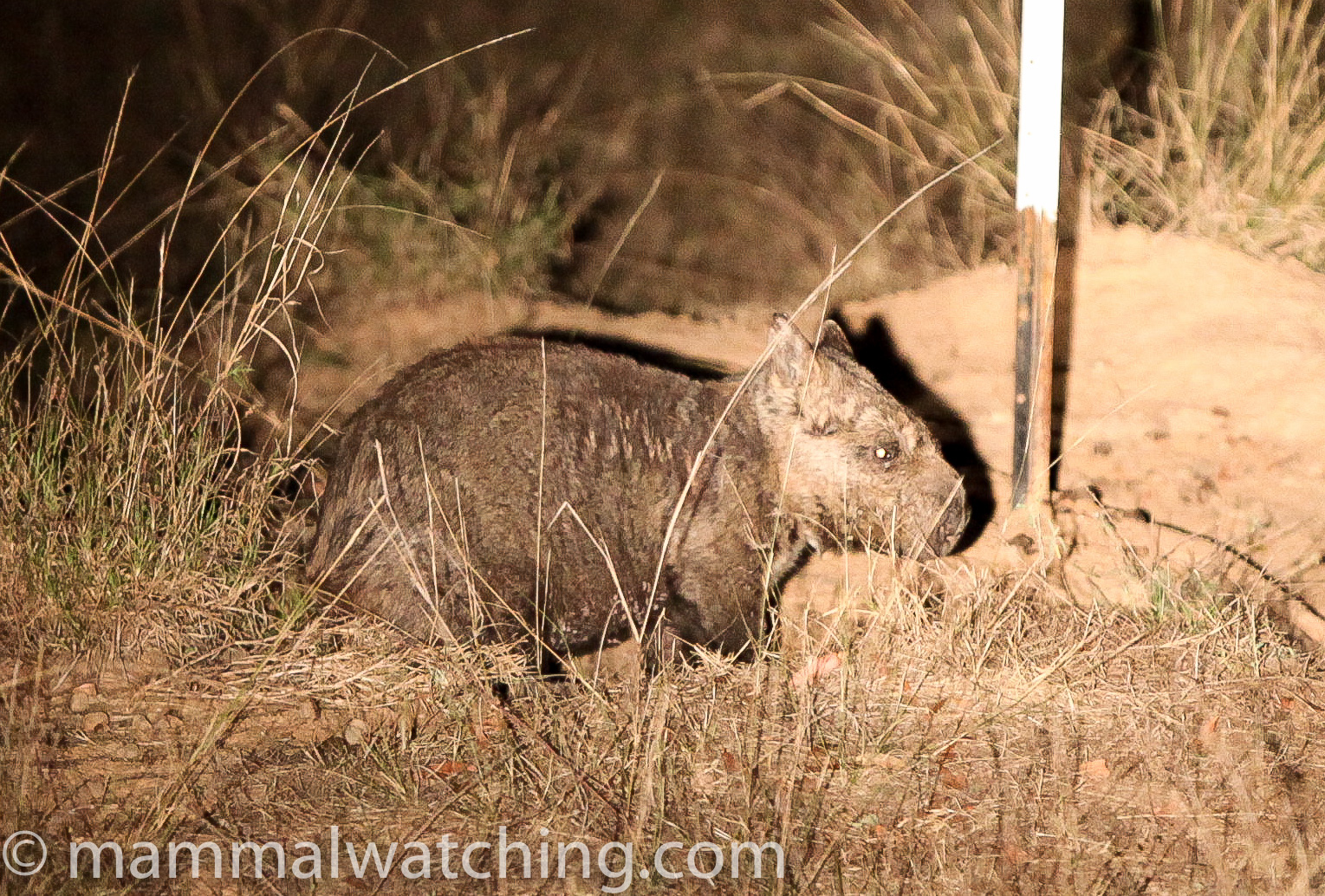
Northern Hairy-nosed Wombat, Lasiorhinus krefftii
Epping Forest National Park near Clermont is home to the world’s last few remaining Northern Hairy-nosed Wombats and can only be entered with a permit. In early September 2011 I spent a couple of nights there. I arranged my visit through Queensland NPWS: the scientist in charge – Alan Horsup – takes volunteers there for one week most months. They typically rendezvous in Rockhampton, 600km from the park and drive in, but I couldn’t go for the whole week so flew to Emerald and met them in the camp after a 3 hour drive.
Although there are only about 160 wombats left in the park, the good news is that they have recovered from a population of fewer than 40 animals in the 1970s , largely thanks to the dedication of Alan over the past 20 years and the predator (largely Dingo) excusion fence that encircles the forest. Indeed as recently as 1997 there were only 65 animals left. A small second colony has now been established at Richard Underwood Nature Refuge, 70km north of St George in south west Queensland.
I saw an Echidna crossing the road about 50km before Epping and then many more inside.
During a night’s spotlighting we saw 5 Wombats, a couple of Rufous Bettongs, a Brushtail Possum (very unusual here), and plenty of Eastern Grey Kangaroos and Swamp Wallabies as well as lots of Rabbits.
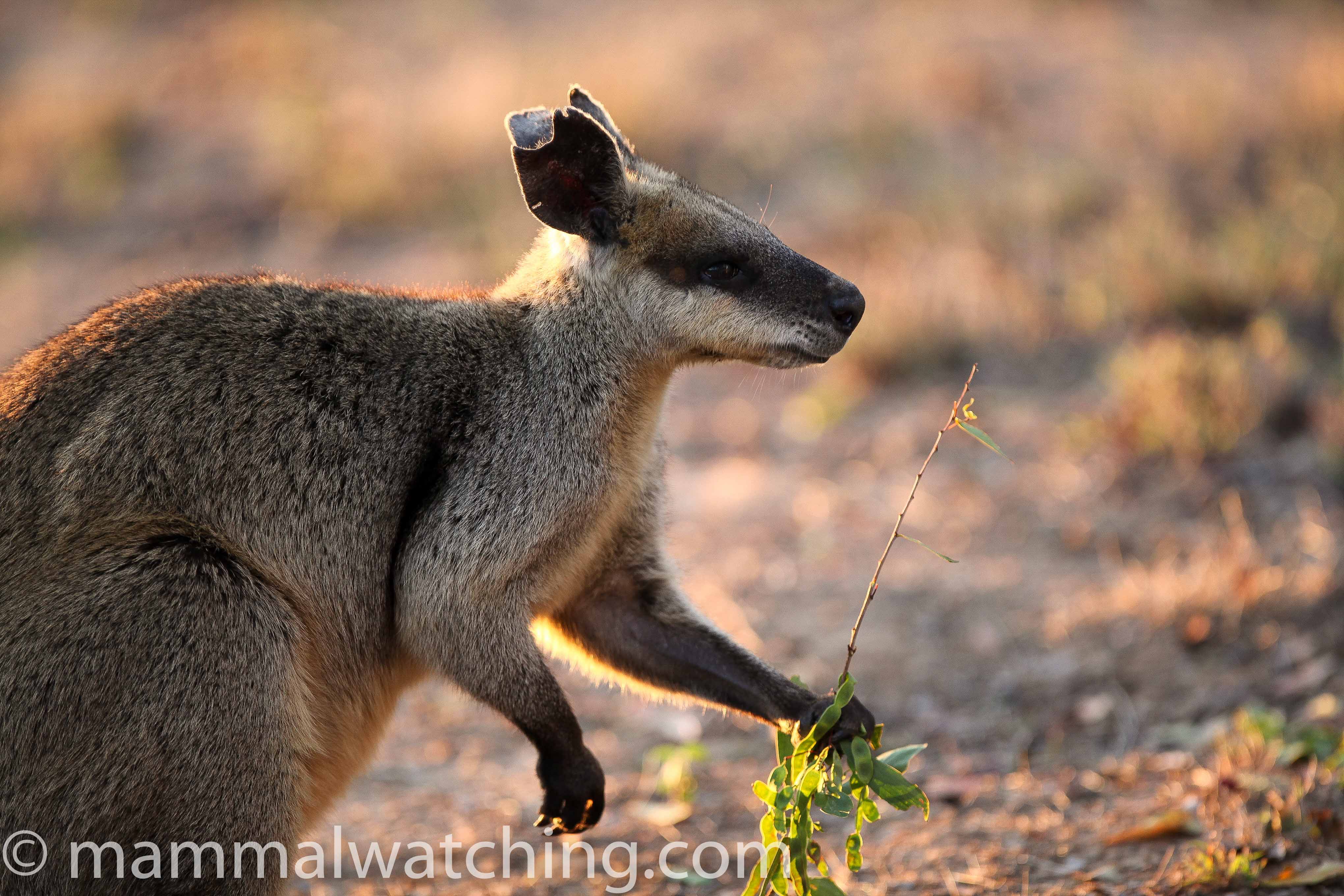
Swamp Wallaby, Wallabia bicolor
I spent thursday working with the other volunteers (brushcutting the Buffel Grass around the complex wombat burrow labyrinths and setting camera traps) and didn’t see much of note other than blisters appearing on my fingers and this impressively large Goanna. Some of the Wombat holes were the size of Aardvark burrows.
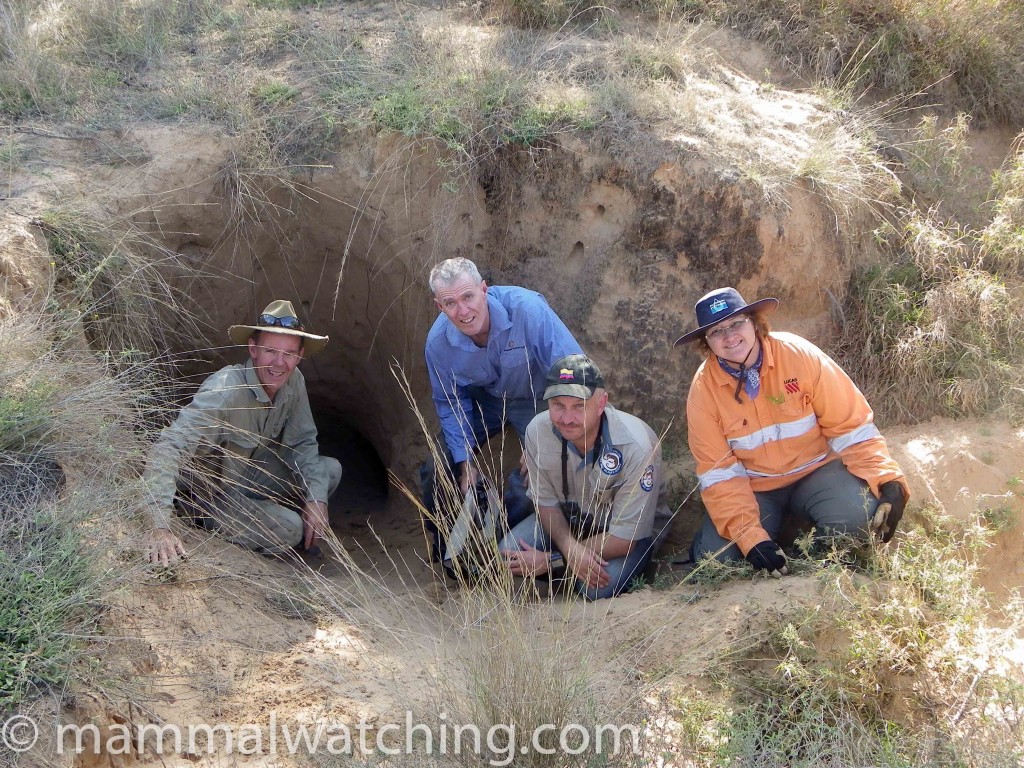
The Ministerial Burrow
We didn’t spotlight on the second night but someone spotted a beautiful Spectacled Hare Wallaby near camp (my first on the mainland). This is a hard species to see so another good reason to visit.
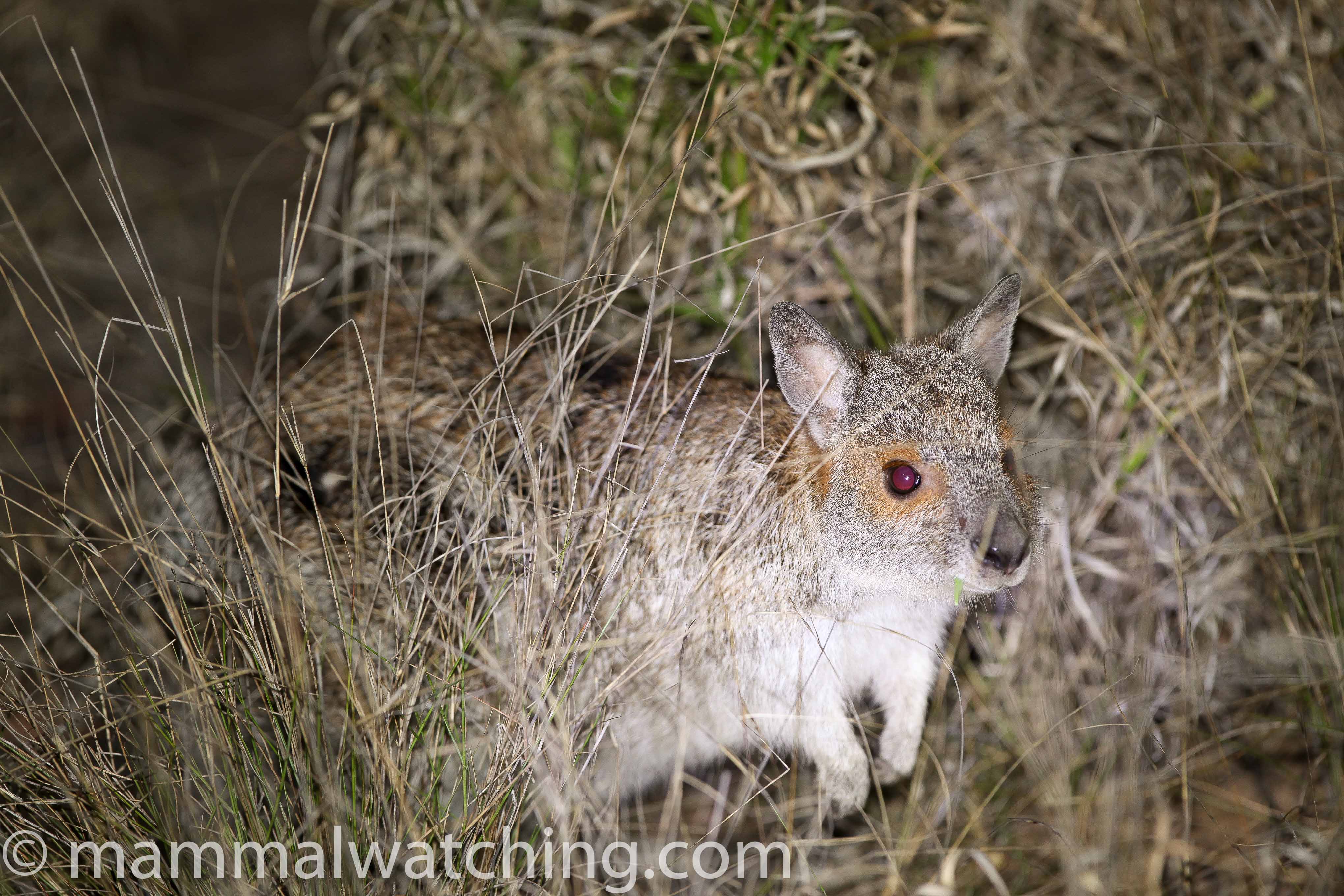
Spectacled hare-wallaby, Lagorchestes conspicillatus
If you are interested in volunteering please contact Alan Horsup.
Mount Isa is home to the recently described Purple-necked Rock Wallabies. One good place to stay and look for them is West Leichardt Station – try looking on the rocks around Spider Bore. As you leave Mount Isa to the east you pass a rocky hill with a Telstra telecommunication tower on top. I saw Purple-necked ROck Wallabies here too. There are a few small caves on the northern side of the top of the hill inhabited by what are now believed to be Troughton’s Tomb Bats (Taphozous troughtoni) as well as Common Sheathtails (Taphozous georgianus). The taxonomy of these species was still under review last time I heard. The roads around Mount Isa are also a good place to look for Spectacled Hare Wallabies.
The Undara Lava Tubes are a popular day trip from Cairns. In the forest nearby you have a good chance to see Antilopine and Common Wallaroos and Whiptail (Pretty-faced) Wallabies. Rufous Bettongs are very common around the lodge in the evening, while Mareeba Rock Wallabies are easy to see near the lava tubes. Several species of bats have been recorded at the lava tubes and Eastern Horseshoe Bats are the easiest to see.
Community Reports
The World’s Best Mammalwatching
Australia has more than its fair share of extraordinary mammals and extraordinary mammalwatchers, none more so than Charlie Roberts, who has lived his whole life in the rainforest on Mount Misery near Cooktown in north Queensland. Charlie, and his brother Lewis, know the land, and its wildlife, like the backs of their hands, and looking for mammals with Charlie is an experience unlike any other. Its pretty much time travel: and I get the impression he sees and experiences that forest in a totally different way than I do. Charlie is the man to find you a Bennett’s Tree Kangaroo. But he can also find pretty much any other mammal in the area you can think of including Striped Possums and Large-eared Horseshoe Bats (the local Robertsi subspecies of which was named after his Dad). I’m pretty sure Charlie will never get email. But you can usually track him down through the Lion’s Den Pub in Helenvale. See more of the World’s Best Mammalwatching.
Community Reports
Cairns to Sydney, Christmas 2024: Mark Hows, 2.5 weeks & 50+ species including Brush-tailed Rock Wallaby, Australian Humpback Dolphin and Long-tailed Pygmy Possum.
Iron Range and North Queensland, 2024: Jane Kempler, 1 month & 40 species including Northern Bettong, Common Spotted Cuscus and Northern Quoll.
Far North Queensland & Sydney, 2024: Greg Easton, 8 days & 15 species including Musky Rat Kangaroo and Rakali (Water Rat).
Townsville, 2023: Michael Sebastian, 3 nights & 9 species including Koala, Large-footed Myotis and Eastern Tube-nosed Bat.
Striped Possums on the Atherton Tablelands, 2023: Michael Johnson’s successful quest to see a Striped Possum near Cairns.
Kid-friendly mammalwatching in SE Qld, 2022: Warren Gilson’s ideas on fun places to see mammals like Black Flying Foxes, Humpback Dolphins and Brush-tailed Rock Wallabies within a few hours of Brisbane.
Atherton Tablelands and Cape York, 2021: Isaac Clarey, 2 weeks & 43 species including Cinnamon Antechinus, Long-tailed Pygmy Possum and Prehensile-tailed Rat.
Caernarvon Gorge, 2021: Ethan Craft’s report of a visit with 6 species including Rufous Bettong and Platypus.
Mission Beach to the Daintree, 2021: Michael Johnson, 1 week and 24 species including Broad-toed Feathertail Glider, Northern Broadnosed Bat, Prehensile-tailed (aka Australian Tree) Mouse and Lumholtz Tree Kangaroo.
Barrington Tops, 2021: Michael Sebastian,1 night & 5 species including Greater Gliders and a Long-nosed Potoroo.
North Queensland, 2021: Brett Taylor, 11 nights & 31 species including both tree-kangaroos, all the endemic ringtail possums, Yellow-bellied and Feathertail Gliders and Coastal Sheathtail Bats.
Queensland, 2019 – Northern Tablelands to Cape York: Part 4 of Jimmy Lamb’s 5 week and 65 species trip including both Cuscuses, Godman’s Rock Wallaby, Coastal Sheathtail Bats and a Cinammon Antechinus.
Dugongs in Moreton Bay, 2019: Michael Johnson’s notes of an easy mammal trip.
Queensland, 2019 – Southern Atherton Tablelands: Part 3 of Jimmy Lamb’s 5 week and 65 species trip including Northern Bettongs, Striped Possums and Feathertail Gliders.
Queensland, 2019 – Eungella to Ingham: Part 2 of Jimmy Lamb’s 5 week and 65 species trip including Unadorned, Allied and Sharman’s Rock Wallabies and Central Greater Glider and Mahogany Glider.
Queensland, 2019 – Central Queensland: Part 1 of Jimmy Lamb’s 5 week and 65 species trip including Herbert’s Rock Wallabies and Bridled Nailtail Wallabies.
Australia, 2018: Valentin Moser’s report of mammals seen over the course of 75 days on several trips. He saw over 100 mammals including Mahogany Glider, both Feathertail Gliders, Proserpine Rock Wallaby, Numbat and Honey Possum.
A Mammalwatching Year, 2018: Jannico Kelk’s account of mammals in WA, Qld and Tas, including Honey Possum, Brush & Red-tailed Phascogales and some nice bats. Wonderful photos.
Queensland, 2018: Ian Thompson, 3 weeks & 41 species including Eastern Tube-nosed Bat, Feathertail Glider and Northern Bettong.
Mackay area and Central Queensland, 2018: Tim Bawden, 9 days & 42 species including Northern Hairy-nosed Wombat, Bridled Nailtail Wallaby and Central Greater Glider.
South East Queensland, 2017: Jimmy Lamb, 10 days & species including Brush-tailed Rock Wallaby, Fawn-footed Melomys and Koala.
Wet Tropics, 2017: Antoni Camozzato, 2 days & 10 species including Platypus and Musky Rat Kangaroo.
Australia, 2016: Mike Hoit, 5 weeks & many species including – in Queensland – Koala, Dugong and Squirrel Glider.
Quick Cairns Area Jaunt, 2016: Tim Bawden, 3 days & 26 species including Striped, Herbert River and Lemuroid Ringtail Possums, Lumholtz’s Tree Kangaroo and a Diadem Leaf-nosed Bat.
Australia, 2016: Domique Brugiere, 2 months and a lot of mammals including Black Wallaroos, Rothschild’s, Cape York, Godman’s, Sharman’s and Proserpine Rock Wallabies plus Bridled Nailtail Wallabies
North Queensland 2016: Jimmy Lamb’s report of 2 weeks around Cairns and the Tablelands, with some great photos and species including Feathertail Glider, Striped Possum and Hoary Wattled Bat.
NSW & Qld borders, 2016: Tim Bawden’s acccount of a long weekend looking for wildlife with mammals including Hump-backed Dolphin, Fawn-footed Melomys, Rufous Bettong and Chocolate Wattled Bat.
WA, Qld & Tas, 2015: Steve Morgan, 4 weeks & 45 species including Tiger Quoll, Honey Possum and Eastern Long-eared Bat.
Australia and New Zealand, 2014/15: Pieter de Groot Boersma, 10 months & 117 species including Brush-tailed Rabbit Rat, Feathertail Glider, Leadbeater’s Possum, Northern Bettong, Prehensile Tailed Rat and Cape York Rock Wallaby. <<Note: the Nailtail Wallaby was in fact Northern, not Bridled. And expert opinion think the mysterious macropod discussed at the end of the report was a Short-eared Rock Wallaby not a Narbalek.>> Click here to search for Pieter’s various videos from Australia.
Queensland and Tasmania, 2014: Romain Boquier, 6 weeks & 63 species including Proserpine Rock Wallaby, Bennet’s Tree Kangaroo and Feathertail Glider in Queensland.
Australia & Singapore, 2013: Andrew and Ben Balmford, 2 months & 98 species! Including, in Qld, Northern Bettong, both Tree Kangaroos, Prehensile Tailed Rat and Black-footed Tree Rat.
A few North Queensland Mammals, 2011: Jon Hall, brief report of a few days around Cooktown, the Daintree and the Tablelands including my first Long-tailed Pygmy Possum.
Northern Hairy Nosed Wombats, 2011: David Andrews, 1 week & 13 species including Northern Hairy-nosed Wombats and Spectacled Hare Wallabies.
Queenland and New South Wales, 2011: Vladimir Dinets, 3 weeks & lots of mammals including a Mahogany Glider and Julia Creek Dunnart.
Queensland, 2008: Dion Hobcroft, 3 weeks & an outstanding 70 mammals, including both Tree Kangaroos, both Cuscuses and a Short-tailed Mouse (Leggadina lakedownensis).
Australia, 2004: Richard Webb, 1 month & an impressive 50 mammals.
Around the World (Australia), 2004: Richard Webb, 6 weeks.
Also See
RFI Proserpine Rock Wallabies at Airlie Beach, December 2024
RFI Iron Range, September 2024
Audible bat call in the Daintree, May 2017
Interesting post on how to find Bilbies, November 2015


Leave a Reply
You must be logged in to post a comment.